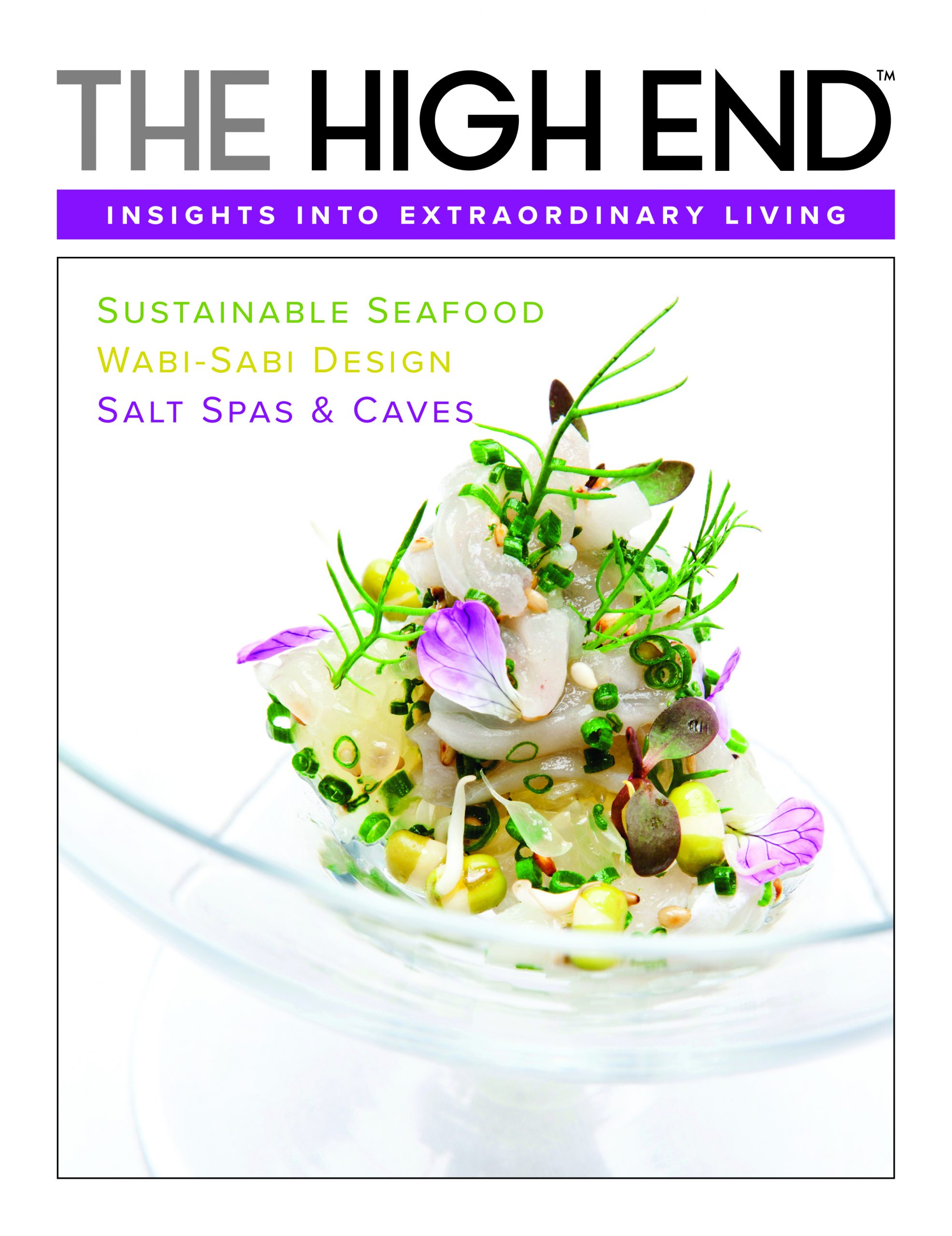Featured image ©istockphoto.com / AntonioGuillem
New technology and the need to adapt have transformed the traditional feel of museums and galleries around the world.
From smartphones to staying at home, the way we experience art has metamorphosed into something more comprehensive.
In a world ruled by social media, viewers are allowed an inside look into the lives of artists all over and their unique way of making art. Everything from gathering materials, to creating pieces, to live streaming exhibits are available. Now, we’re getting an inside look at entire collections, and it’s easy and accessible.
In Rotterdam, Netherlands, and part of the lush, rosebush-filled Museumpark, is the Museum Boijmans Van Beuningen. The museum displays an incredibly diverse collection of art and right beside it, donned in over 1,500 mirrored panels is the museum’s depot.
“Museum Boijmans Van Beuningen has a collection of more than 151,000 artworks but — like all museums worldwide — only displays between 6 to 8 percent in the galleries. The remaining objects are kept in storage facilities, closed to the public,” says Ina Klaassen, museum director of Depot Boijmans Van Beuningen. The first of its kind, the depot will transform the way visitors view the museum’s collection.

The Musée du Louvre has never before been so accessible. The museum’s most obscure and most well-known pieces are just a click away.
©istockphoto.com / TomasSereda
Open since autumn 2021, the depot creates a one-of-a-kind opportunity in the art world. “The entire collection will be accessible to the public — a world first — and will be stored at a single location next to the museum,” according to Klaassen. Even the building itself is a masterpiece. Created by the architects of MVRDV — a global architecture practice — the mirrors brilliantly reflect the surrounding museumpark, which allows the depot to seamlessly blend into the existing cityscape.
Certainly not alone in their quest to enhance the art world, the Musée du Louvre in Paris, France is also striving for something similar. The museum has moved the impressive entirety of its collection to an online platform and launched a new website, which extends the experience for those who have already visited or hope to visit in the future. “Today, the Louvre is dusting off its treasures, even the least-known,” according to Jean-Luc Martinez, president/director of the Musée du Louvre. “For the first time, anyone can access the entire collection of works from a computer or smartphone for free, whether they are on display in the museum, on loan, or in storage.”
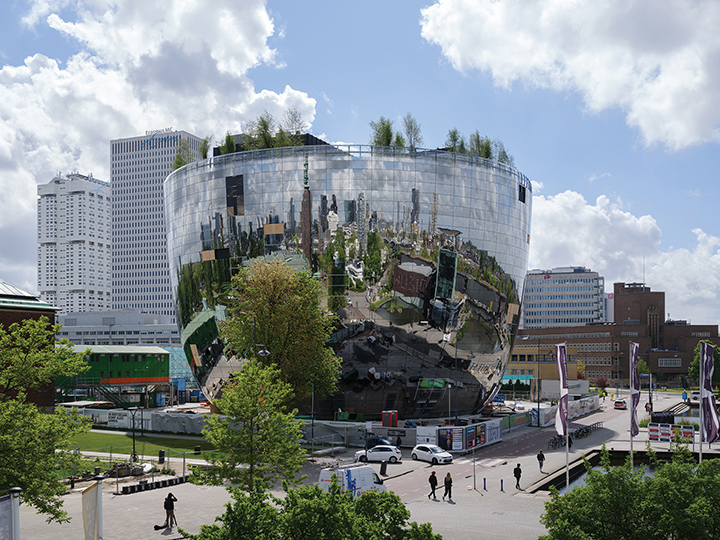
The architects of MVRDV have created an iconic building, giving a boost to the Rotterdam Museumpark. The choice to use mirrors came with the idea to make the surrounding park appear bigger, integrating the building into the landscape.
Photo by Ossip van Duivenbode.
Even prior to the pandemic, museums, galleries, and artists were working to bring art from all over the world to the masses. The British Museum, in partnership with the Google Cultural Institute, created a highly interactive timeline through history with the option to explore multiple eras, continents, and cultures throughout history and art. The Renwick Gallery at the Smithsonian American Art Museum offers virtual exhibits that take advantage of the additional space for lengthier descriptions and personal narratives from artists.
These innovative techniques continue to expand the way we experience museums and galleries. “A museum and the new publicly accessible art depot are very different,” says Klaassen. “The museum has three main functions: namely the displaying of a collection in an art/historical context, as well as conserving and researching it. The museum is the showroom, the depot is behind-the-scenes.”
The idea that an entire collection can be available is a glimpse into the future of art and adds an element of freedom when viewing it.
Typically, art in a closed depository is not accessible to the public; only a small, select group has the privilege. Approximately 95-percent of the Depot Boijmans Van Beuningen is open to the public where they can “witness museum activities such as the packaging of objects out for loan and other conservation and restoration activities,” says Klaassen.
These new types of displays and virtual tours extend the art — even the most prestigious pieces — to the far corners of the world. “The dynamics in the depot will be different from those of the museum: in the museum, exhibitions are presented, whereas the depot allows for the visitor to explore the collection of more than 151,000 objects in whatever way they like,” adds Klaassen.
France’s iconic museum has integrated an interactive map and its website allows visitors to easily navigate through different mediums, themes, or even specific rooms in the museum. “The Louvre’s stunning cultural heritage is all now just a click away,” says Martinez. Each entry is a comprehensive display of the piece, with data such as the title, artist, inventory number, dimensions, materials and techniques, date and place of production, object history, current location, and bibliography included.
For the first time in history, the art in the Musée du Louvre is accessible for viewers at any time. It is suddenly possible for visitors who missed an exhibit or simply wish to revisit a piece to do just that. These changes are shifting the relationship between art and viewers to a new level, which will only elevate the overall experience of museums and galleries. “I am sure that this digital content is going to further inspire people to come to the Louvre to discover the collections in person,” says Martinez.
The Musée du Louvre’s new website is also a place where original content is made accessible for both in-person and virtual visitors, such as live and recorded podcasts, lectures, and concerts, web series, animated stories, filmed exhibition walk-throughs, interviews, and more. “We look forward to welcoming the public to join us on a journey behind the scenes and experience all facets of working with such a high-end art collection,” notes Klaassen about the depot.
The sleek, modern design of the exterior continues inside the depot. Once inside, visitors will have the option for guided tours or to explore the building independently and peek inside restoration studios and other spaces normally closed to the public.
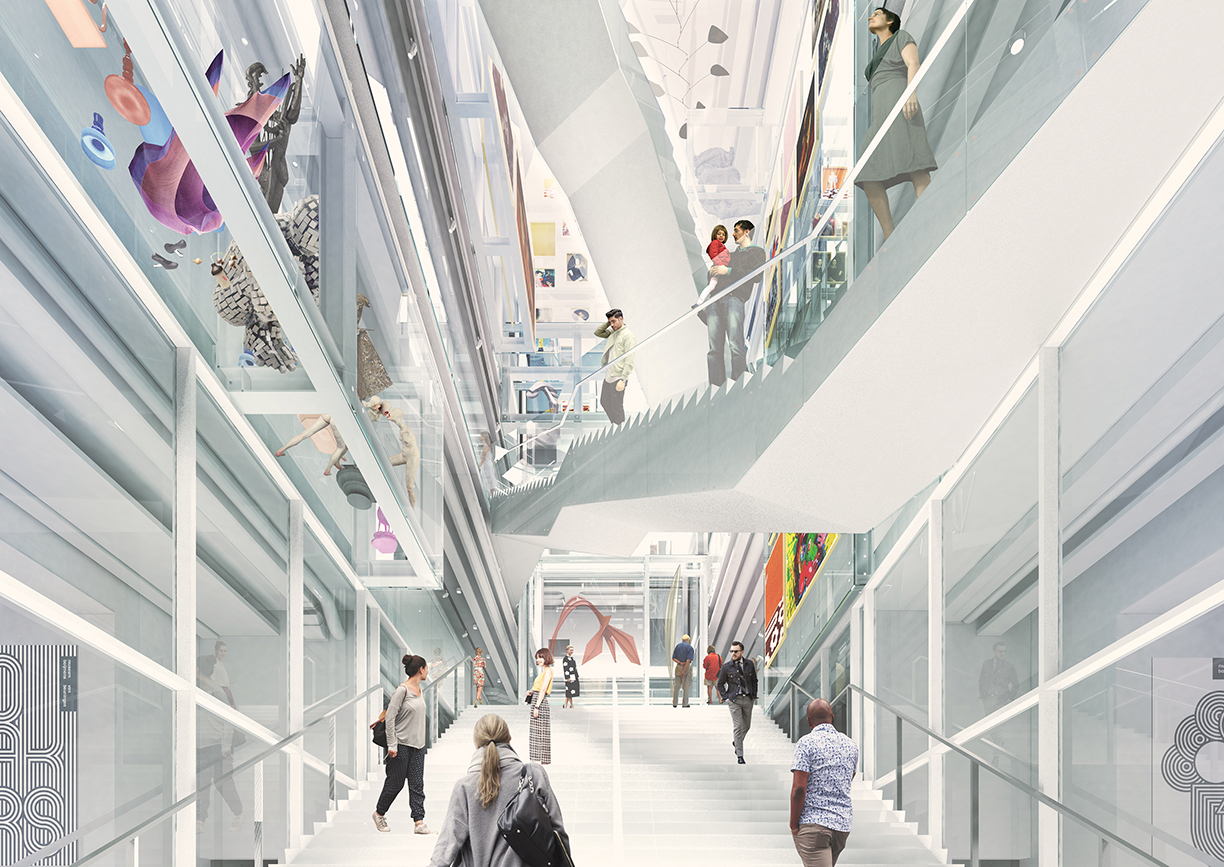
Photo by Ossip van Duivenbode;
Rendering courtesy of Depot Boijmans Van Beuningen
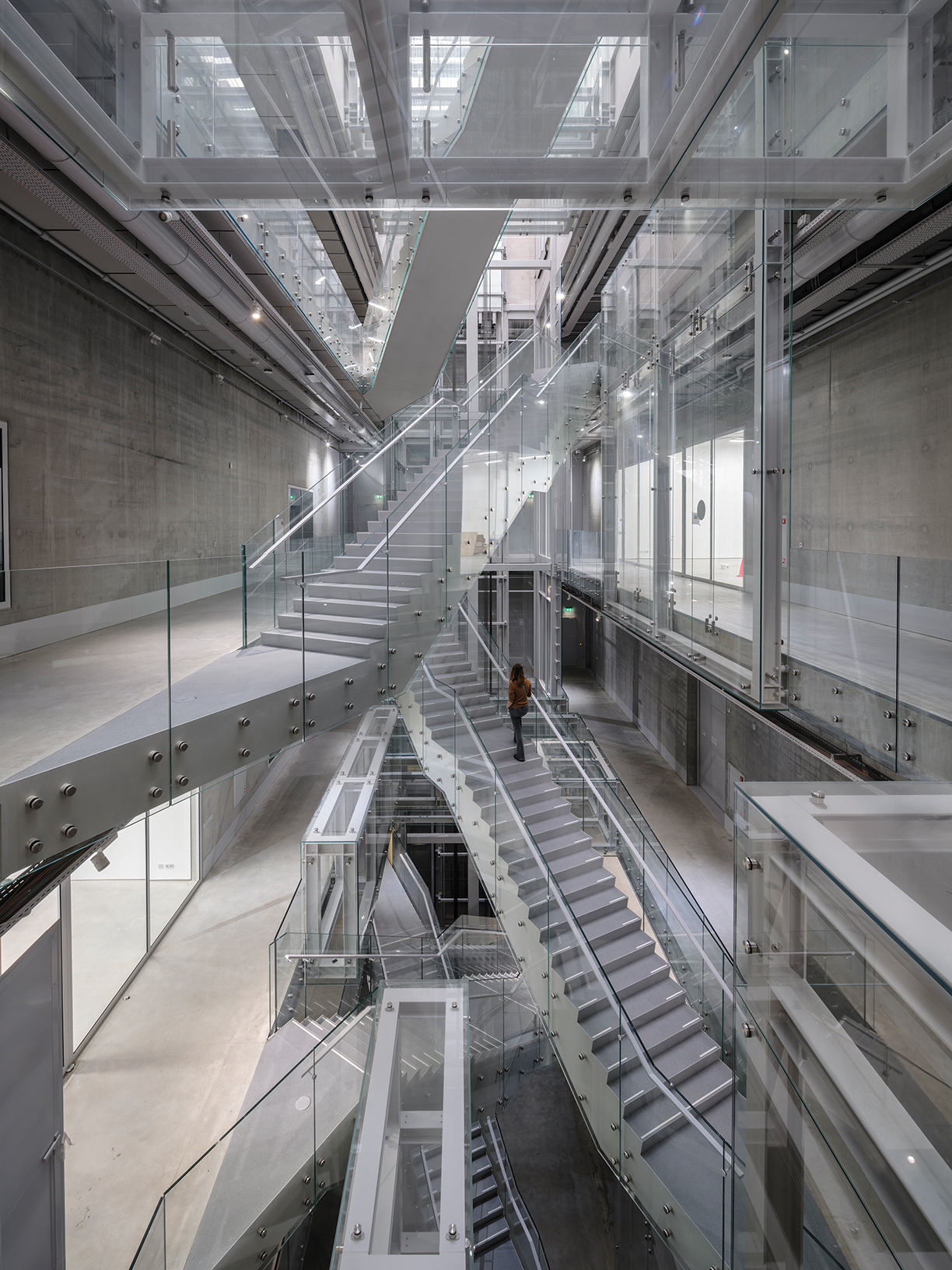
Culdesac will be the first neighborhood-scale community with zero residential parking, which will allow for more open spaces that can be used for socializing, events, and getting to know your neighbors.
Rendering by Opticos Design.
A five-minute city, car-free and golf cart centered communities are gaining momentum around the United States, from Port Aransas, Texas, to Tempe, Arizona.
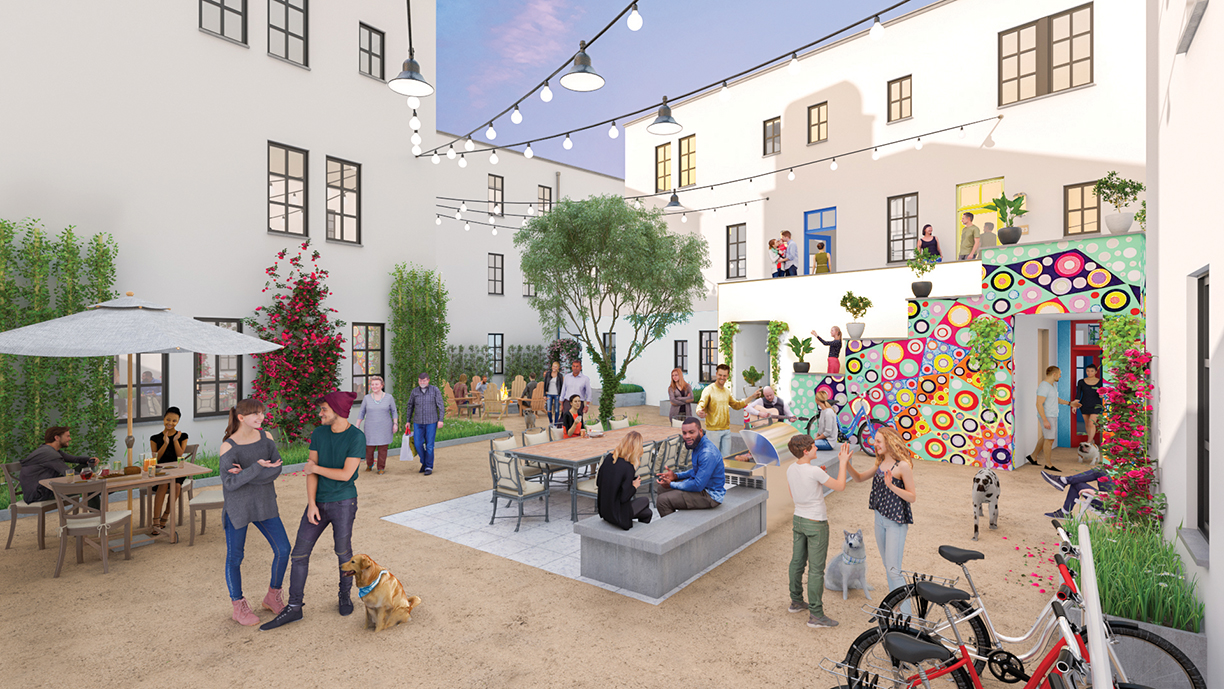
With plenty of extra outdoor space, Culdesac will hold over 150 events per year, including concerts, food trucks on the plaza, outdoor yoga classes, and more that guests can enjoy close to home.
Rendering by Opticos Design.
Automobiles have long been a symbol of freedom and advancement, making it easy to overlook the strain they put on our communities and the environment. Even smaller cities are battling noise and air pollution as the number of cars per household increases. Long commutes, congested traffic routes, parking fees, and pollution have all encouraged a whole new way of thinking when it comes to cars.
Culdesac, in Tempe, Arizona is the first car-free community in the United States that has been built from top to bottom around the idea that cities can be made better. “The vision has always remained the same — to build cities for people and not cars,” says Culdesac’s general manager, Lavanya Sunder. Space that is typically reserved for roads, parking lots, and individual parking has been completely rethought in this rental apartment community. Parking lots and garages have been replaced with wide-open spaces that offer everything from fire pits and hammocks to water features and inviting courtyards.
Tempe, Arizona, offered the ideal canvas for a project like Culdesac. “We chose Tempe for its thriving job market, proximity to transportation, and forward-thinking, action-oriented local government,” says Sunder. These are among the added benefits when considering a car-free community.
“By removing parking lots, we were able to see all of the possibilities, twice the retail, triple the open space, and 55-percent landscape coverage, compared to less than 20 percent from comparable developments,” notes Sunder.
The community was designed as a five-minute city, meaning everything residents might need is within reach and life is at your front door. “Homes at Culdesac all open up to vibrant shared courtyards, versus impersonal hallways in traditional apartment complexes,” says Sunder. Seemingly small details such as this contribute to the overall atmosphere that is created when a place urges its residents to slow down. “Community is a key component of Culdesac. Culdesac will have over 150 events per year, including concerts, food trucks on the plaza, outdoor yoga classes, and more.”
Communities such as Culdesac are finding that residents are drawn to the idea of knowing their neighbors again. A notion that hasn’t been overlooked in other communities around the United States. Port Aransas, Texas, is a beautiful beach destination that is like traveling back in time. The eclectic atmosphere is entirely accessible by golf carts, including the 18 miles of beach, with spacious boardwalks that accommodate the carts and encourage foot traffic. The use of golf carts decreases traffic, noise and pollution, and creates a very relaxed pace around the island. Cinnamon Shore, the 1,000-acre, master-planned beachfront community is very walkable and designed with families in mind who want to enjoy the small-town feel in Port Aransas.
A private luxury community, Haig Point, on the northern end of Daufuskie Island in South Carolina is only accessible by ferry, and the island is almost entirely car-free. Residents and guests never have to worry about traffic, stopping for gas, or finding a parking space, as the island runs mainly on golf carts. Similarly, Fire Island, across the Great South Bay from Long Island, New York, is another popular summer retreat that functions smoothly without cars. Bikes, golf carts, and jet skis are the best way to experience the Fire Island’s top-tier accommodations.
According to the Bureau of Transportation Statistics, “the mean number of vehicles in households is 1.9 personal vehicles…. Thus, it appears that households on average have more vehicles than drivers.” American cities, from New York to San Francisco, are struggling to provide enough space to merely park all of these vehicles, nevermind drive them.
Our personal space, green space, shared space, and even sidewalks have decreased significantly over the years as the need to accommodate a growing number of automobiles increases.
Communities such as Culdesac are hoping it is time for the urban form to be rethought and upgraded. “We also will have an “Extend Your Home On-Demand” Program,” says Sunder.

Communities such as Cinnamon Shore in Port Aransas, Texas, are embracing the idea that guests want a slower pace without sacrificing accessibility.
©istockphoto.com / IR_Stone

Car-free and golf cart centered communities are designed for those looking to reconnect with the outdoors and spend less time stuck in traffic.
©istockphoto.com / 300dpi
“Residents will have access to a variety of bookable spaces to allow them to expand and contract their home as needed.” A modern way of living has melded with the traditional idea of small-town communities. “Culdesac will have bookable guest suites, podcast studios, hosting spaces, and day-use office spaces to allow your home to adjust to your needs,” Sunder explains. “Why pay for a guest room 365 days a year, when you only use it a few times a month?”
Forever shifting to accommodate the residents’ needs, a car-free community like Culdesac is ideal for many people, even during these changing times amidst a pandemic. “The idea of life at your front door makes Culdesac Tempe a place that a variety of people with different needs are interested in — young professionals, students, families, remote workers, retirees, empty nesters, et cetera,” says Sunder. More spacious apartments and public workspace are functional for those residents who are working remotely, as they also don’t have to worry about commuting into an office every day. Since the pandemic, “we’ve seen increased interest from folks particularly from New York and San Francisco, and 50 percent of our waitlist are people coming from outside Arizona,” notes Sunder.
Cover image: ©istockphoto.com / Rost-9D
In the male-dominated field of architecture, women struggle to overcome institutionalized barriers to gender equity.

At her eponymous New York City studio, architect Nina Cooke John creates sophisticated spaces through “high-impact” residential architecture.
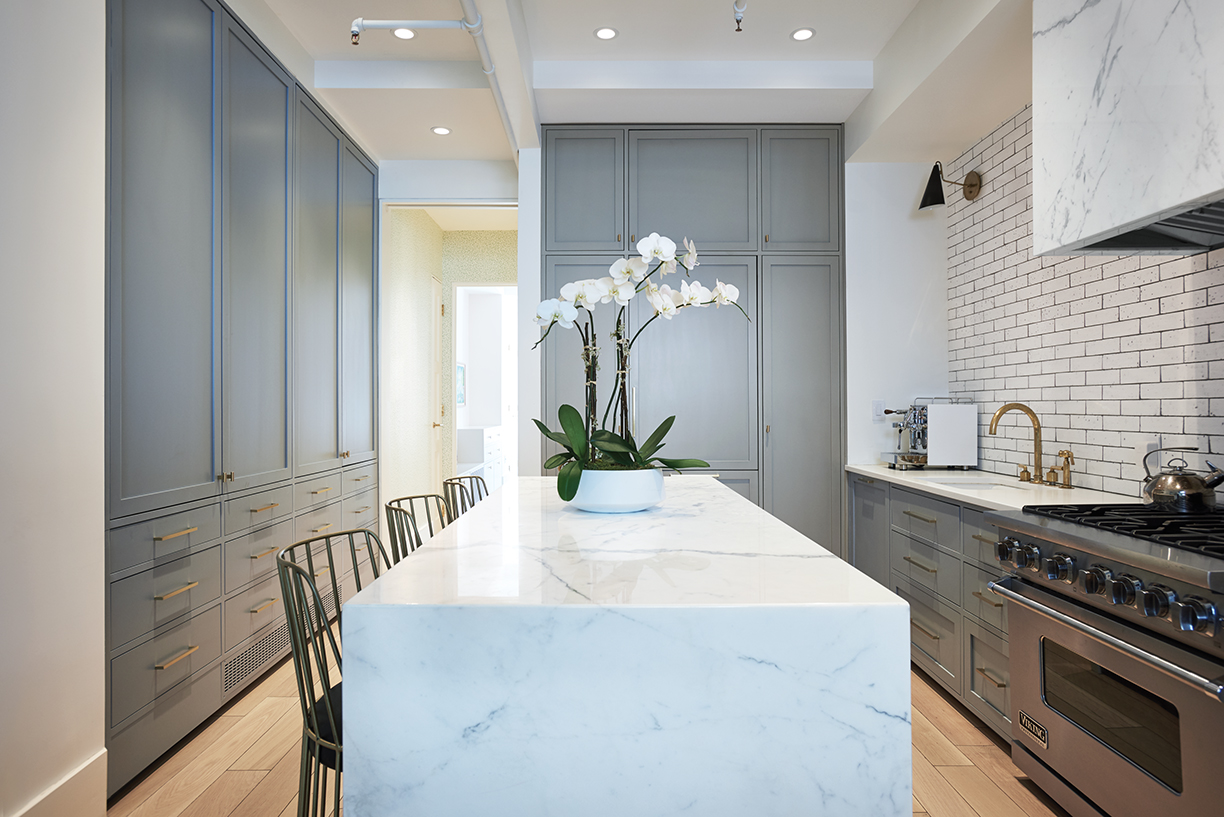
Nina Cooke John photo by Ball & Albanese; Below photo by Lisa Russman Photography.
Courtrooms are increasingly occupied by women attorneys and even judges, and world-class hospitals have no shortage of women physicians. But, regrettably, the profession of architecture remains nearly as male-dominated as the halls of the U.S. Senate or Fortune 500 boardrooms. In a field that demands both artistic achievement and construction expertise, gender equity has been painstakingly slow.
There are certainly some bona fide celebrity women architects, such as Jeanne Gang who is dramatically redefining the skyscraper, and Elizabeth Diller whose firm of Diller Scofidio + Renfro created The High Line in New York and The Broad in Los Angeles. They follow Zaha Hadid, the trailblazing Pritzker Prize-winning designer who passed in 2016. The prominence of these women has inspired a new generation of female architects, but that path is still laden with roadblocks.
Despina Stratigakos, Ph.D., vice provost for inclusive excellence and professor of architecture at the University at Buffalo, states, “Architecture is a male-dominated profession by design,” and explains that there was strong pushback when women first started entering the field 140 years ago. “The justifications given then for excluding them from practice, revolving around women’s negative ‘feminine’ influences, became embedded as core values of the professional culture,” says the professor, who reports that a deep-seated bias against women’s abilities continues today.
Stratigakos’ 2016 book, Where Are the Women Architects? was partly inspired by the emergence of a new movement seeking greater gender equity in the profession. “I wanted to raise awareness of this long-standing question and of the voices of activists pushing for answers today,” she explains. “Women have long advocated for greater diversity in architecture, but too often have been ignored by the profession’s leaders,” says Stratigakos.
The professor cites statistics that reflect approximate gender parity among students enrolled in accredited architecture programs in the U.S. but that is not, however, indicative of women’s advancement in the profession after graduation. “Although the gap has shrunk between the numbers of men and women studying architecture, racial and ethnic disparities are slower to change,” adds Stratigakos, who notes that Black women are sorely underrepresented in architecture schools.
While challenges for women of color can be dispiriting, voices like Nina Cooke John provide inspiration for those entering the field. The Jamaican-born architect, whose New York-based Studio Cooke John specializes in “high-impact” residential architecture — she explains the concept as maximizing and customizing every square inch of the spaces she describes as “machines for living” — and public art.
Cooke John, whose impressive resume includes degrees from Cornell and Columbia, was included in Dwell magazine’s “13 Extraordinary Women in Design and Architecture You Need to Know.” Following faculty positions at Syracuse University and Parsons School of Design, she has returned to Columbia to teach architecture, making the professor well suited to counseling young women entering the field. Informed by her experience as one of the few Black women in her class at Cornell, she advises, “It’s important to speak out and create your own community because support is paramount to your success.” She suggests that if students who feel isolated cannot find that support on campus, they should reach out to practitioners or minority-based professional associations for mentorship.
After practicing and teaching extensively, Cooke John created her own firm with another woman architect — both mothers of young children who appreciated the flexibility most large firms could not provide — and eventually went solo. She reports, “For many women, it’s about finding your voice and creating an environment that’s difficult to find in a male-dominated firm.” Suggesting women tend to approach the profession differently, Cooke John reports, “When women interact with clients, it’s not so often about ego but listening to the clients and responding to their needs.”
“We interact with the built environment constantly, and while some people view it as in the background, it’s really the foreground of everything we do,” says Cooke John, who adds, “When people engage with one another in public spaces, community-building is much stronger.” Her foray into public art installations further advances her philosophy of placemaking, which transforms relationships between people and the human-made environment.
Julia Gamolina is director of strategy at Trahan Architects, an international firm with offices in New Orleans and New York, whose portfolio includes prominent educational, sports and performing arts venues. She is also founder and editor-in-chief of Madame Architect, an online magazine that celebrates the achievements of women in the field and serves as a digital mentor to young professionals. Explaining that challenges for women are exacerbated by influences beyond their own architectural firms’ cultures, Gamolina observes, “Most professions dealing with the built environment, such as commercial real estate, construction and engineering, tend to be even more male-dominated than architecture.”
The editor of Madame Architect not only laments the lack of gender equity in her industry, but suggests progress is unlikely to be swift. “It’s slow to change because architecture itself takes a long time, from financing and government approvals to design and construction,” explains Gamolina, another accomplished Cornell alumna. She reports the numbers of women in leadership positions is more anemic than overall female participation in the industry, but notes some women start their own firms after becoming mothers.
Other women, reports Gamolina, drop out of the rigorous profession when they have their first child because employers do not offer sufficient flexibility. “It’s not a motherhood problem at all,” insists the architect and journalist, who maintains that lack of flexibility applies equally to fathers and even caretakers of elderly parents. One potential dividend from the pandemic was the recognition by employers that staff can be fully productive working outside the office.
Gamolina believes young women need to understand there are exciting roles awaiting them in architecture beyond design itself, and points to her own director of strategy position at Trahan Architects. “Madame Architect showcases all the career possibilities within the field,” she explains, citing specialties in administration, communications and marketing.
Rosa Sheng is a principal at SmithGroup, whose 15 offices create cultural centers, master-planned cities and mixed-use projects around the globe. Sheng also serves as her firm’s director of justice, equity, diversity, and inclusion, and is founding chair of the Equity by Design Committee created by the San Francisco chapter of the American Institute of Architects (AIA).
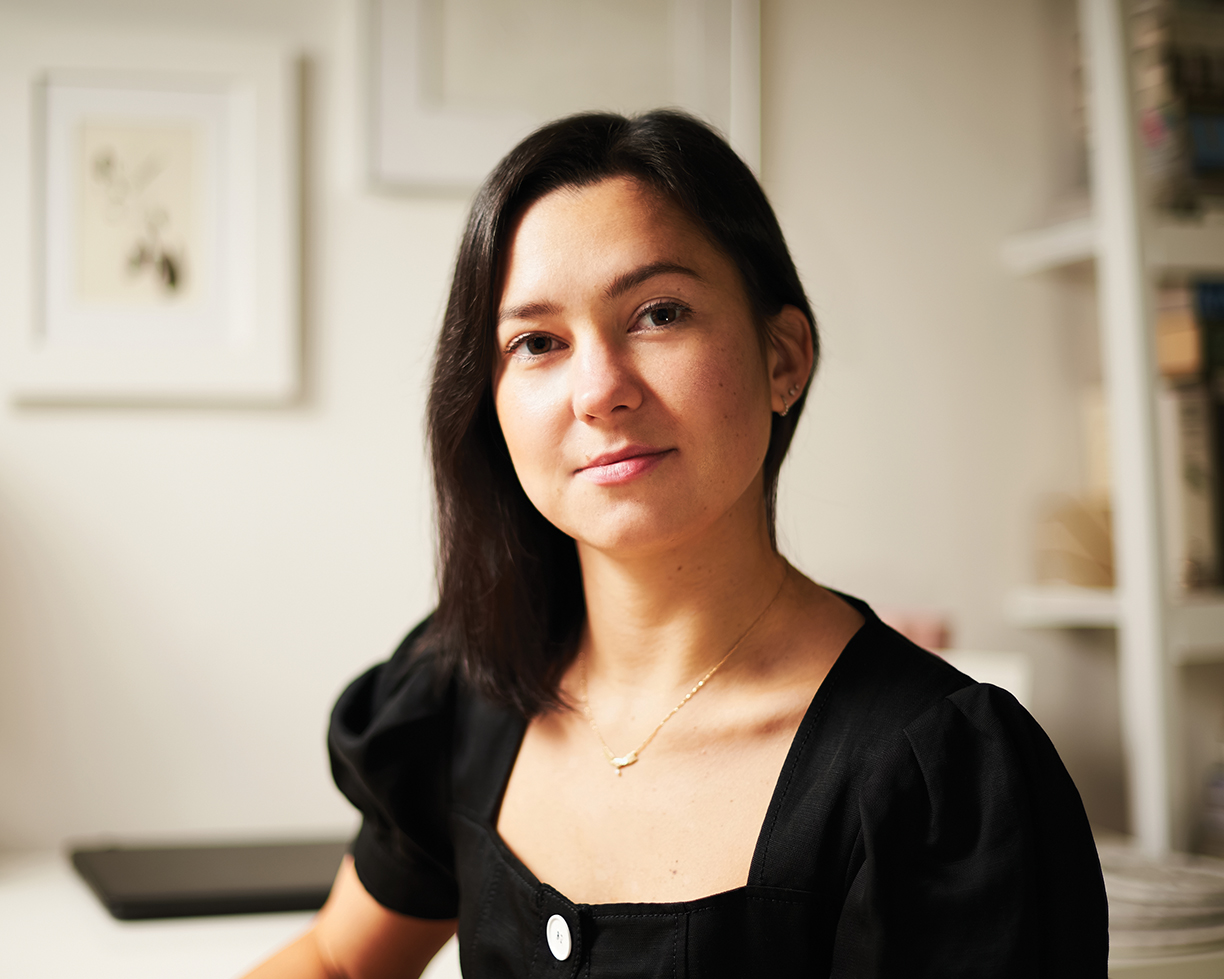
Julia Gamolina is director of strategy for Trahan Architects — the Coca-Cola Stage at Atlanta’s Alliance Theatre is a signature project — and is also editor-in-chief of Madame Architect.
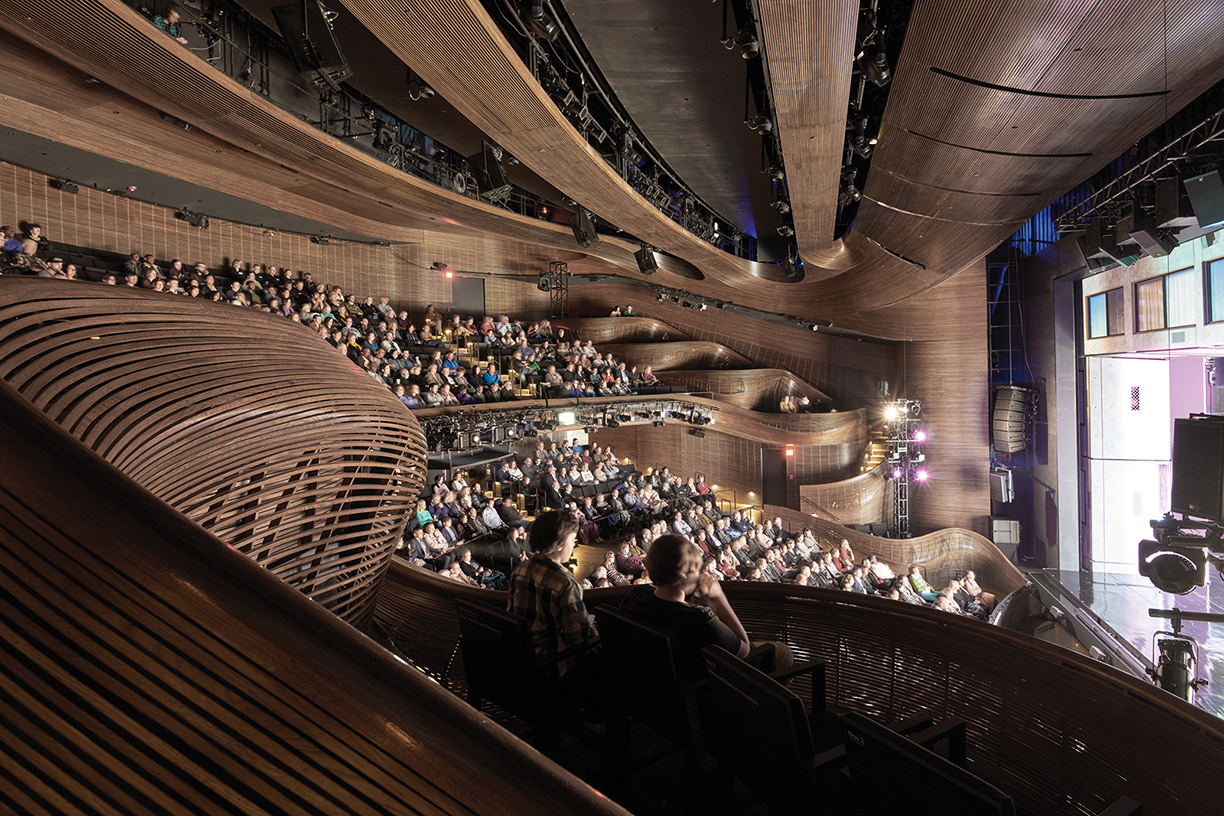
Photo of Julie Gamolina by Lily Olsen; Theater photo by Leonid Furmansky.


Equity by Design has conducted three pivotal research studies with the most recent, in 2018, involving a survey of more than 14,000 architecture school graduates. For Sheng, therefore, anecdotal stories from her colleagues are supported by hard data. Her research reveals several “pinch points” in the careers of women architects: pathways to licensure, access and opportunities to leadership positions, caregiving navigation/reconciliation, and pay equity for similar roles or positions. Her committee’s early work focused on the “missing 32 percent,” referring to the attrition rate between women architecture school graduates and those who became licensed.
After giving birth to her second child during the Great Recession, Sheng was experiencing one of those pinch points. “I felt like I couldn’t be a good parent or a good architect,” she recalls defeatedly, and adds, “People say there are barriers, but you don’t believe it until you experience them.” In challenging times, women leave the profession, something Sheng herself considered even after years of success. But her work with Equity by Design has provided a new purpose to complement her passion for the discipline. “It’s that feeling of being swept away by the excitement, like, ‘Wow! There’s something here we can influence and help to change,’” explains the activist architect.
Sheng reports, “In addition to Equity by Design, there are many more women in architecture leading efforts to share experiences, celebrate achievements for justice and equity in the profession, and inspiring a more diverse demographic of architectural practitioners.” She cites organizations like 400 Forward, a nonprofit that inspires women of color to become architects.
“Your success will not be determined by your gender or your ethnicity, but only on the scope of your dreams and your hard work to achieve them.” This is not just any motivational trope, but the words of the great Zaha Hadid, who overcame challenges on both fronts.
Rosa Sheng, a principal at SmithGroup — the UC Davis Teaching and Learning Complex is a recent project — was founding chair of the Equity by Design Committee.
Photo by Scott R. Kline; Building renderings courtesy of SMITHGROUP.
Cover photo by Scott Selzer.
Customized pergolas bring the best of the indoors out — whether used as an airy yoga studio, home theater, or al fresco living space.
The pergola, an outdoor structure with support beams and a decorative roof design, is a great way to extend living space and increase the amount of time spent outdoors. Providing shade on a hot day, pergolas are traditionally associated with entertaining in the spring, summer or fall. Now, one company’s personalized, high-tech pergola with a fire pit, hanging heaters, and retractable, vinyl screens can extend the outdoor season into Northern winters as well.
StruXure creates custom exterior pergolas with wind, rain, snow, and freeze sensors that automatically activate the pergola to open, close, pivot, and slide. CEO and Chief Product Architect Scott Selzer was a middle school teacher working part time in construction, until he discovered a niche market in the construction industry — the pivoting louvered-roof structure that could be controlled and customized by its users.
The system can be operated through voice commands by integrating technology such as Amazon’s Alexa and Google Assistant. “You’re in control of the weather instead of the weather being in control of you,” Selzer says.
When the weather is warm, the screens will open to allow fresh air to fill the space. The louvers pivot 170 degrees; open and close the louvers as the sun shifts in the sky to ensure maximum comfort.
“Bringing the indoors out can change the way you live,” Selzer says. “The Pergola X and Cabana X serve as an extension of the home, making it possible to spend more of your life outdoors.”
“To me, a pergola is a really cool, personal space,” Seltzer adds. “I’ll go under my Pergola X with my laptop and it’s a great place to get work done.”
Made from fully extruded aluminum, the structure can be used as a home office, outdoor kitchen, workout area, or an additional living or dining space. Selzer has even created an outdoor home theater, complete with motorized screens, an integrated projector, and stadium seating. “I’ve seen it all,” he says. “If you can think it, you can do it.”
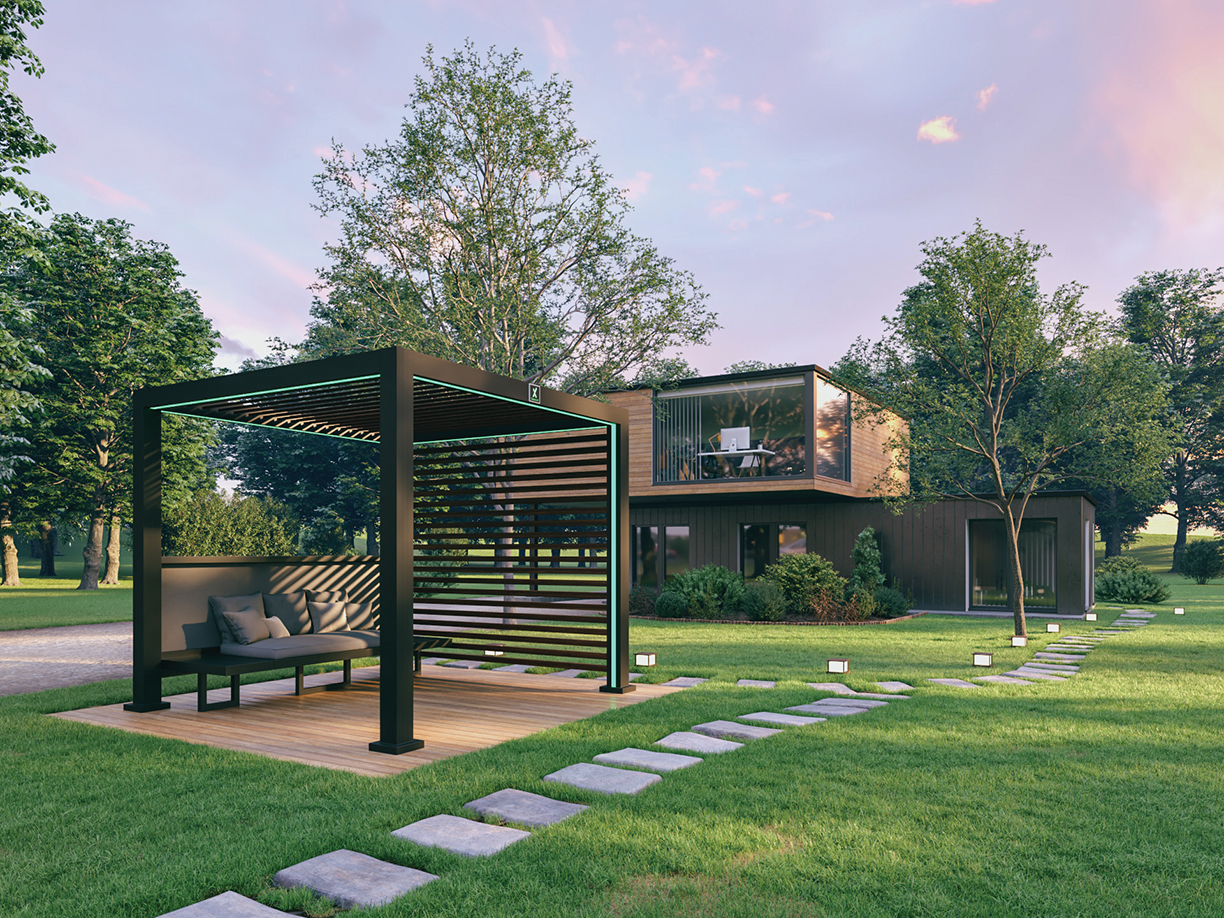
The Cabana X is a freestanding structure that can be taken down at any time and does not need to be professionally installed.
Photo courtesy of Cabana X.
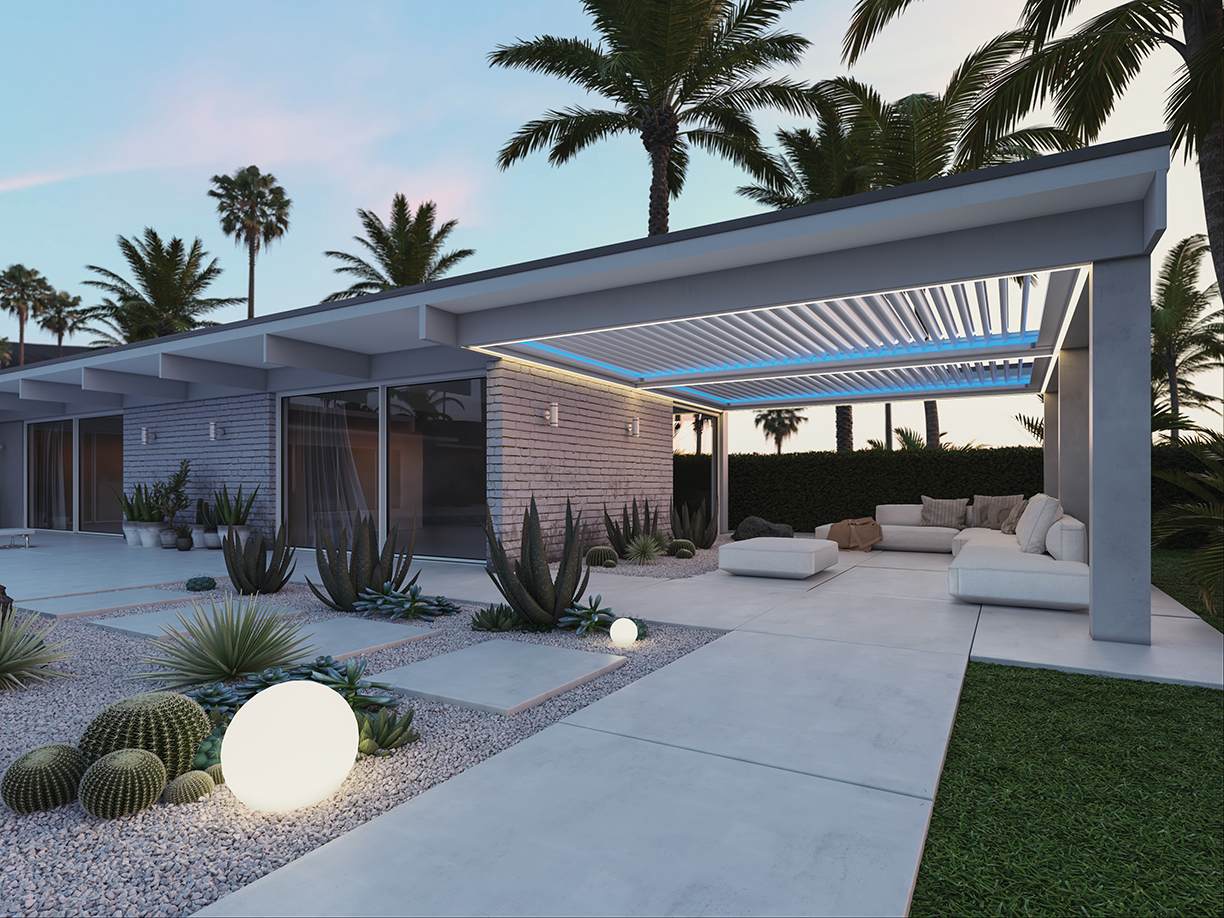
The TraX system allows shades, screens, and lights to be seamlessly integrated into the anatomy of the pergola.
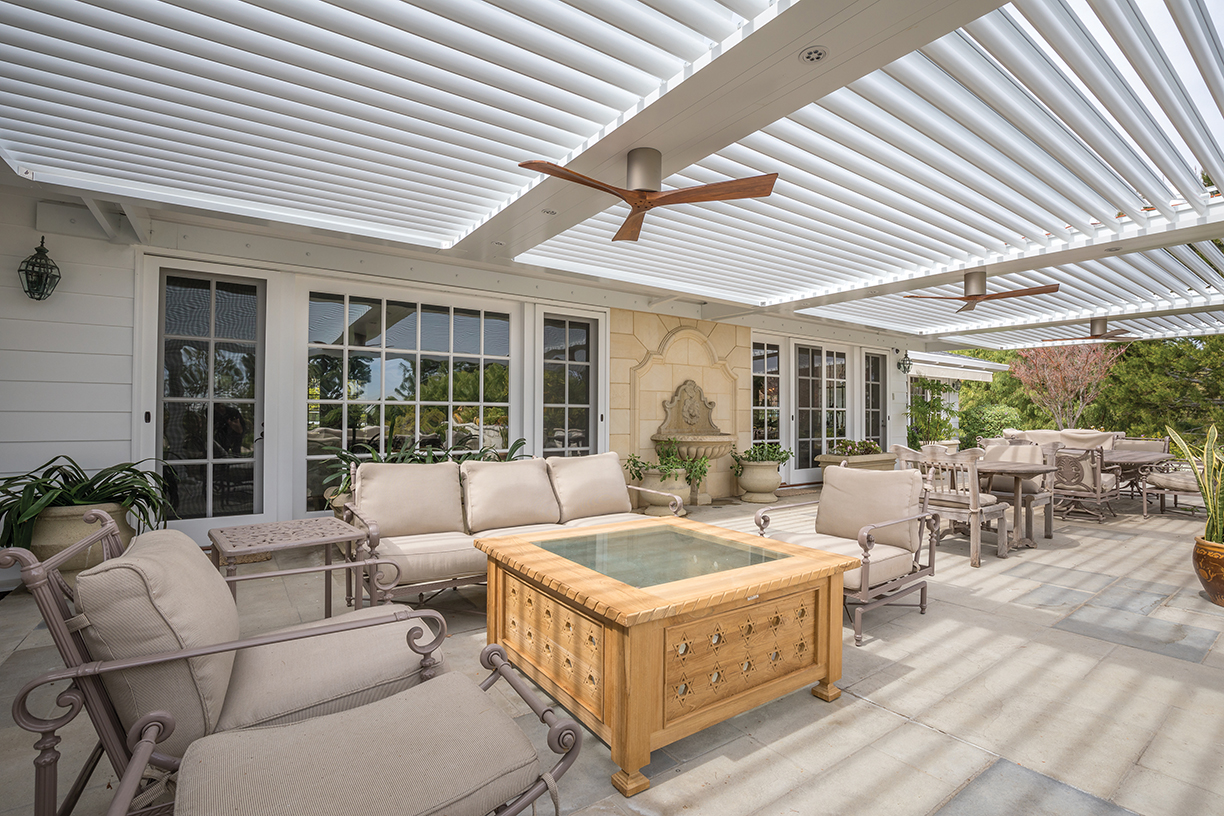
From small patios to large decks, the Pergola X can be a great addition to any outdoor space. This structure was built to open, close, pivot, and slide at the touch of a button.
Photos by Shaye Price.
The TraX system allows shades, screens, and lights to be seamlessly integrated into the anatomy of the pergola. Clients can incorporate curtains, speakers, and ceiling fans as well.
Pergolas can be customized to match any architectural style to ensure the structure will blend effortlessly with the rest of the property. Add corbel ends for a more traditional look, or wrap the columns with rough cut cedar for a rustic, woodsy design.
“By itself, the pergolas look super modern, but you can really customize the product to look like it fits right into any aesthetic,” says Selzer.
When asked what advice he’d offer first-time buyers, Selzer says, “I would challenge homeowners, designers, and architects to think about how the structure will function in the backyard and how the homeowner will live in and use the space. Before the structure is built, consider the accessories that you’ll want — such as motorized screens, heaters, and misting systems. Then, uniquely design the pergola to meet those needs.”
From high-tech gadgets to digital exercise classes, technology continues to change the way we work out.

Tonal is an all-in-one fitness system that uses machine-learning to curate a personalized workout.
Whether you’re at home or visiting the gym, technology plays a crucial role in modern-day fitness. Fitness studios and gyms across the world have embraced technology — like virtual reality or integrated LED lighting — to create innovative, immersive workouts.
As the fitness industry continues to adapt, the home workout evolves even more rapidly. With virtual kickboxing classes, adjustable dumbbells, or comprehensive fitness apps, there are thousands of ways to work out from the comfort of your own home. “Technology has allowed the convenience of an at-home workout,” says Chris Stadler, CMO of Tonal. “At-home fitness equipment gives people a lot of time back, and time is increasingly our top commodity.”
While technology may decrease the need for face-to-face contact with a trainer, it offers a level of unmatched personalization. Technology can curate your fitness plan, track your form as you run, and adjust your weights digitally as you work out. “At-home fitness technology has evolved to meet consumers where they are and on their own terms,” says Amanda Murdock, director of fitness at Daily Burn. “Working out from home allows people a new level of convenience and customization when it comes to meeting their fitness goals.”
Live-Streaming Fitness
Digital workout videos — particularly live-streaming fitness classes — are a great alternative to guided, group fitness instruction. Working out alongside a
personal trainer in real time adds a level of personalization and comfort to a workout. Programs like Daily Burn make it easy to get the workout you want when you want. “At home, you can find any type of workouts that work best with your schedule and at your specific level,” says Murdock. There are many ways to stay active — whether it’s with Pilates, yoga, or high-intensity interval training. “Streaming and on-demand fitness programs like Daily Burn allow more people to begin their fitness journeys without a sometimes-pricey gym membership or access to boutique fitness classes.”
Total-Body Workout Machines
High-end technology allows for a superior workout with much less equipment. An innovative, compact device can remove the need for a room of exercise machines or a basement filled with big, bulky weights. Tonal uses digital weights that can be adjusted easily by a single pound — making for a more precise workout. Smaller than a flatscreen TV, the device makes thousands of calculations a second to deliver up to 200 pounds of electromagnetic resistance. “Tonal will know you better than any personal trainer would at a fraction of the price,” says Stadler. “We’ve seen Tonal completely change people’s lives and their fitness routine. It takes all the guesswork out of strength training.”
If cardio is more your speed, there is Peloton — another well-known, high-tech, total-body exercise machine. Whether you prefer the Peloton Bike or the Peloton Tread, the built-in touch screen and sound bar will make it easy to immerse yourself in the live-streaming workouts.

A subscription with Daily Burn offers digital workout classes and live-streaming fitness.
Fitness Apps
Modern-day technology has led to the creation of countless fitness and health apps, making it easier to work out from home. “Gym time can be hard to find, but more often there is time for a quick workout at home,” says Lisette Fabian, co-CEO of 8fit — a holistic health app that offers a number of fitness plans. A quick self-assessment on 8fit will help to match the user with a fitness plan, and interactive elements help to further predict your preferences and needs. “Apps like 8fit are providing a very personalized experience, so that the user gets the best results possible,” says Fabian. The app curates fitness plans that consist of 6 workouts — from yoga to boxing — within a 2-week period. Users also have access to healthy meal plans, as well as self-care guidance, stretching exercises, and sleep meditation.
Virtual Reality
High-tech fitness, like the power of virtual reality, is a great way to create an immersive, full-body workout for those who bore easily while exercising. The world’s first virtual reality gym, Black Box VR pairs virtual reality technology with resistance training, gaming principles, and high-intensity cardio to redefine your workout. Step into a Black Box room with a customized headset, where your fictional reality will come alive. “We are big believers in pairing the immersive power of virtual reality technologies with modern exercise science principles to help people stick to their fitness goals and ultimately level up their lives,” says Preston Lewis, CCO and co-founder Black Box VR — which has its first boutique gyms in San Francisco with plans to expand. “Innovations in the technology will also drive prices down, allowing Black Box technology to be accessible from the comfort of your own home,” says Lewis regarding the future of Black Box VR.
Fitness Trackers
Fitness trackers and watches have made it easier to work out on your own without the help of a trainer. Whether you’re biking, running, or swimming, devices like Moov Now can track your form, offer encouragement and suggest improvements.
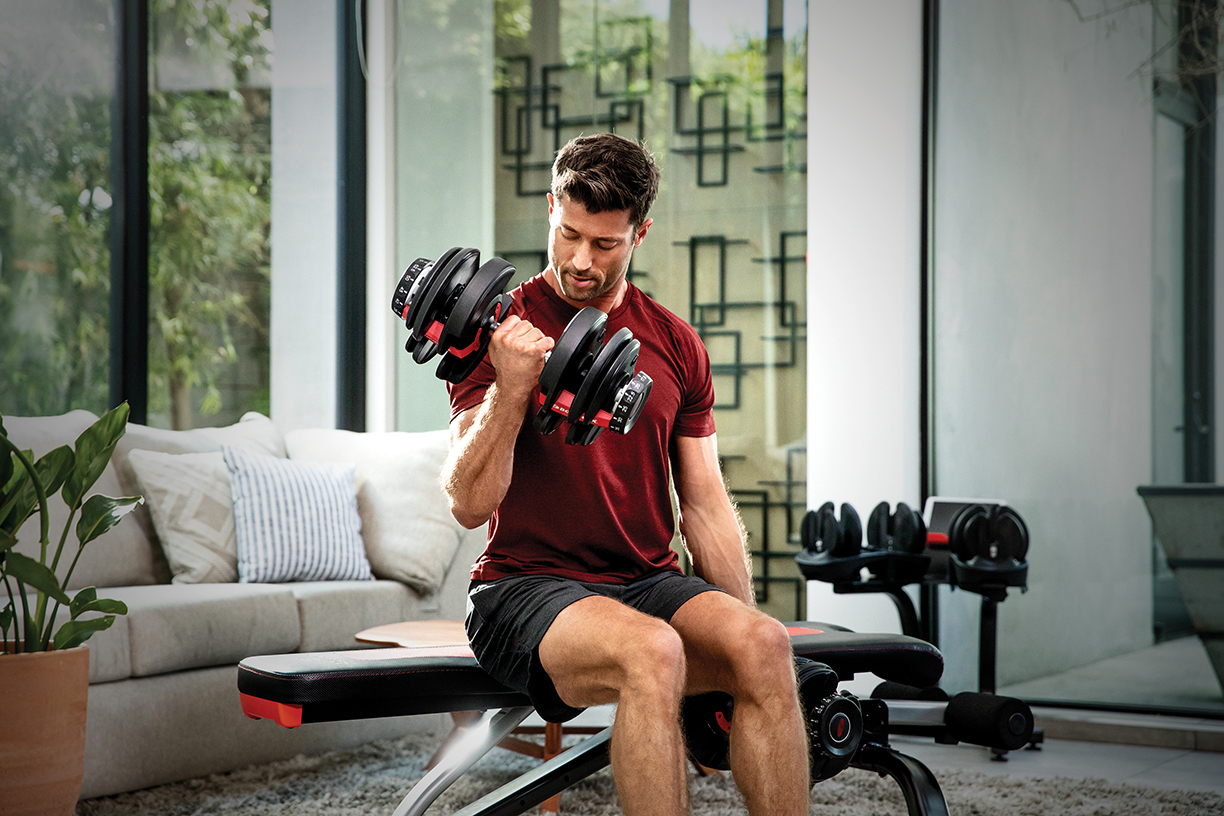
High-tech equipment like the Bowflex adjustable dumbbells make it easier to workout at home.
Adjustable Dumbbells
Whether you don’t have the space to store a full set of weights or you simply love the ease of high-tech fitness, it may be time to invest in adjustable dumbbells. The Bowflex SelectTech 552 Dumbbells will replace 15 sets of weights; technology allows the dumbbells to easily adjust from 5 to 52.5 pounds. Users can quickly modify their resistance and gradually increase strength while using the app. “Right now, adding structure is more important than ever — especially when it comes to staying active,” says Tom Holland, Bowflex fitness advisor. “It’s vital for your well-being to establish healthy habits now, which is where technology steps in to support.”
For Anna Bario and Page Neal, designing jewelry meant more than choosing the perfect stone — it meant making a lasting impact. Their company, Bario Neal, was born from the idea that “our most precious things come with a story,” and the beginning of that story is of utmost importance.
Sustainable fashion has eased its way into the growing culture of being environmentally mindful, and with this movement came an increase in jewelry companies focusing on how to source gemstones and metals without causing a devastating impact on the environment. For Bario and Neal, the principal and lead designers of their company, they sought to create jewelry with a meaning, saying, “to us, creating objects of lasting value means understanding their full impact and origins. [That means] the places the raw materials come from, all the hands that touch the materials and the jewelry as it’s made.”
The Philadelphia-based company creates all their jewelry pieces by hand, with all their diamonds and colored gems being traceable, mine to market products. The design process starts with the aesthetics of the piece, then to how it will be crafted and its functionality, says Bario and Neal. “Then we work out how to make it responsibly. That can mean researching new sources, new materials, or custom cutting.”
Along with supporting sustainable jewelry, the company, which mainly creates engagement and wedding bands, also supports LGBTQIA rights, working to “undermine and eliminate the presumption of heterosexuality that pervades much of the wedding and jewelry industry,” says Bario and Neal. “Supporting unity and advocating for human rights within the jewelry industry is a non-negotiable part of our mission.”
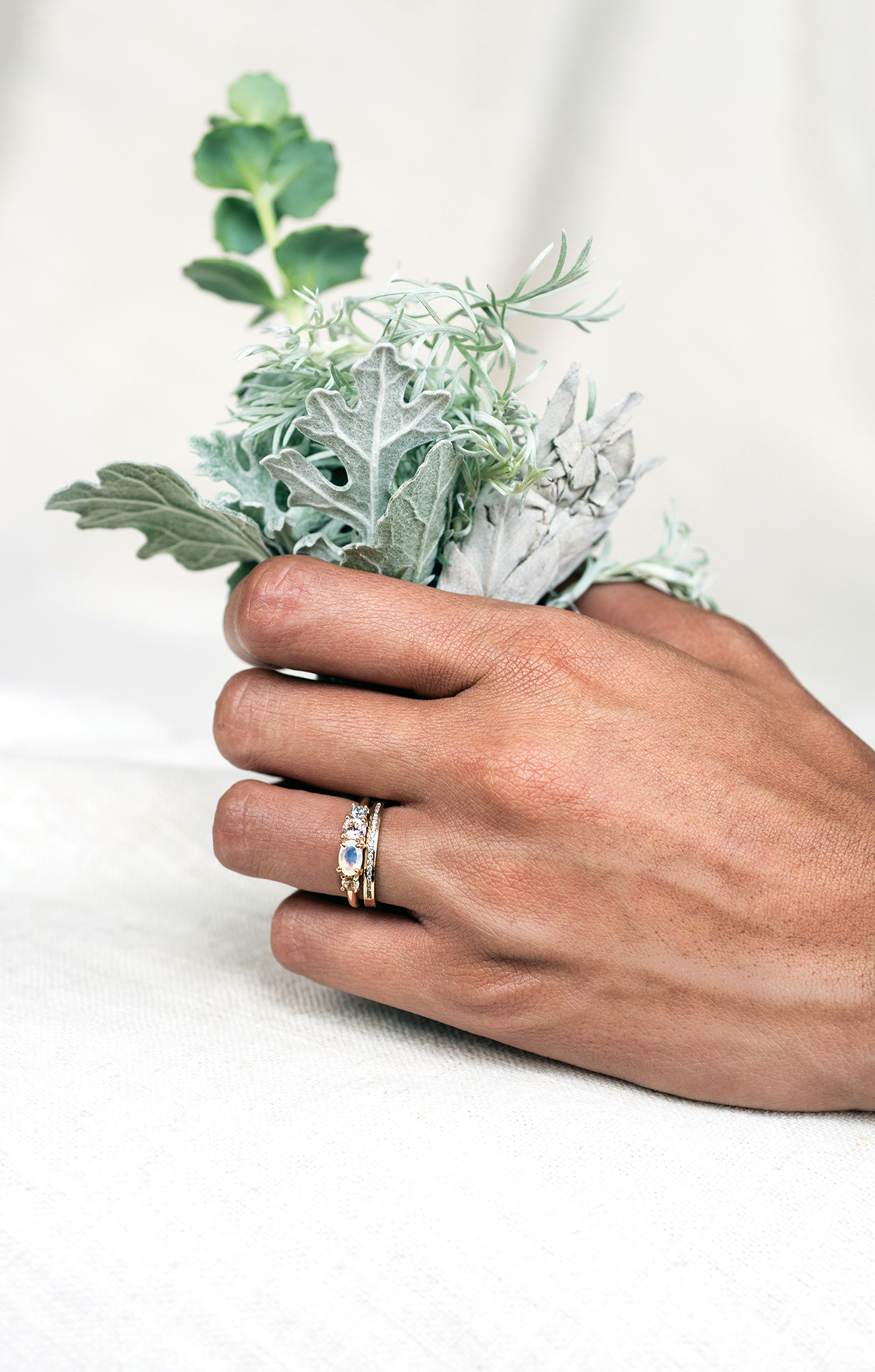
©Bario Neal Jewelry
Bario Neal

Photo by Daniel Johnson
Caitlin Cimino
Like Bario Neal, for Caitlin Cimino and her namesake jewelry company, the story of her ethically sourced pieces is essential to her craft. Cimino, who started her company in 2010, takes a hands-on approach when it comes to her creations. “When I create jewelry, I tie a mindful practice around the entire process — from collecting plant material to sifting through mine debris for gemstones.” Cimino started her ethical business knowing the connection between the jewelry industry and the gemstone and metal mining industries, two industries that are “environmentally and ethically damaging,” Cimino says.
All the gemstones Cimino finds are collected from a privately owned mine in California where her company is based. According to her website, unlike other mines that neglect their surrounding environment, the mine Cimino visits encourages local ranchers to utilize their mining debris in their orchards. The metal she uses is high-quality, up-cycled sterling silver with its impurities removed, making the quality similar to newly mined metal. Cimino describes her jewelry as “Medicine Jewelry™” and has created a process surrounding this ideal. “When I sit at my workbench, I perform different ritual practices like lighting herbs and incense, saying prayers or mantras and setting intentions,” Cimino says. “I do this because everything we involve ourselves in has a story and energy intertwined within, and I believe in the importance of making the story of my jewelry pure and positive.”
For co-founder of the jewelry company Puck Wanderlust, Ranelle Chapman, a core mantra pulls together the focus of her brand with it being “one of collaboration and the shared wealth of skills to create something unique yet mindfully made,” says the company’s website. “The interest in sustainability is at the heart of the brand — from packaging to production.” Founded in 2015 in London, the name is derived from “Puck,” a mischievous fairy in English folklore, and “Wanderlust,” a strong desire for travel and adventure. The company’s team traveled outside of its home country to India and Bali where its jewelry is handcrafted.

Sun Mandala bracelet in silver
by Puck Wanderlust.

A mix of different gold rings with onyx and moonstone by Puck Wanderlust.

Photos courtesy of Puck Wanderlust
Moon Mandala pendant necklace in gold
by Puck Wanderlust.
Puck Wanderlust works with small family-owned suppliers in these countries, their suppliers using recycled materials where possible while providing fair wages for their staff. According to the company, “we are committed to the ethical sourcing of our semi-precious stones and work closely with suppliers to ensure that they adhere to our code of conduct, which outlines strict standards of business behaviour.”
Puck Wanderlust also draws design inspiration from the countries that provide them with their materials. The latest “Bombay Deco Collection” is inspired by Indian Art Deco with geometric motifs and vibrant colors and patterns, according to Puck Wanderlust. In this collection, every design is handcrafted using 100-percent recycled silver and 18-carat gold vermeil, with each stone being “lovingly set.”
Niki Grandics, founder and designer of Enji Studio Jewelry in California, also sources her materials from around the world, buying them as close to the source as possible, she says, with rutile coming from a Pyramid mine in Bahia Brazil and her rich red rubies from Liberia. Grandics, who has always loved fashion and design, chose to ethically source her materials after the Rana Plaza factory collapse in 2013. The devastating event killed over 1,100 garment workers and injured over 2,000 more people, shaking the fashion industry to the core and causing companies to change where they source their materials. “The factory produced clothing for large brands I shopped with at the time,” Grandics says, “and it was shocking to me that so many young women — most garment workers are women age 18 to 35 — died so that young women like me in the West could buy the latest trends.”

Puck Wanderlust
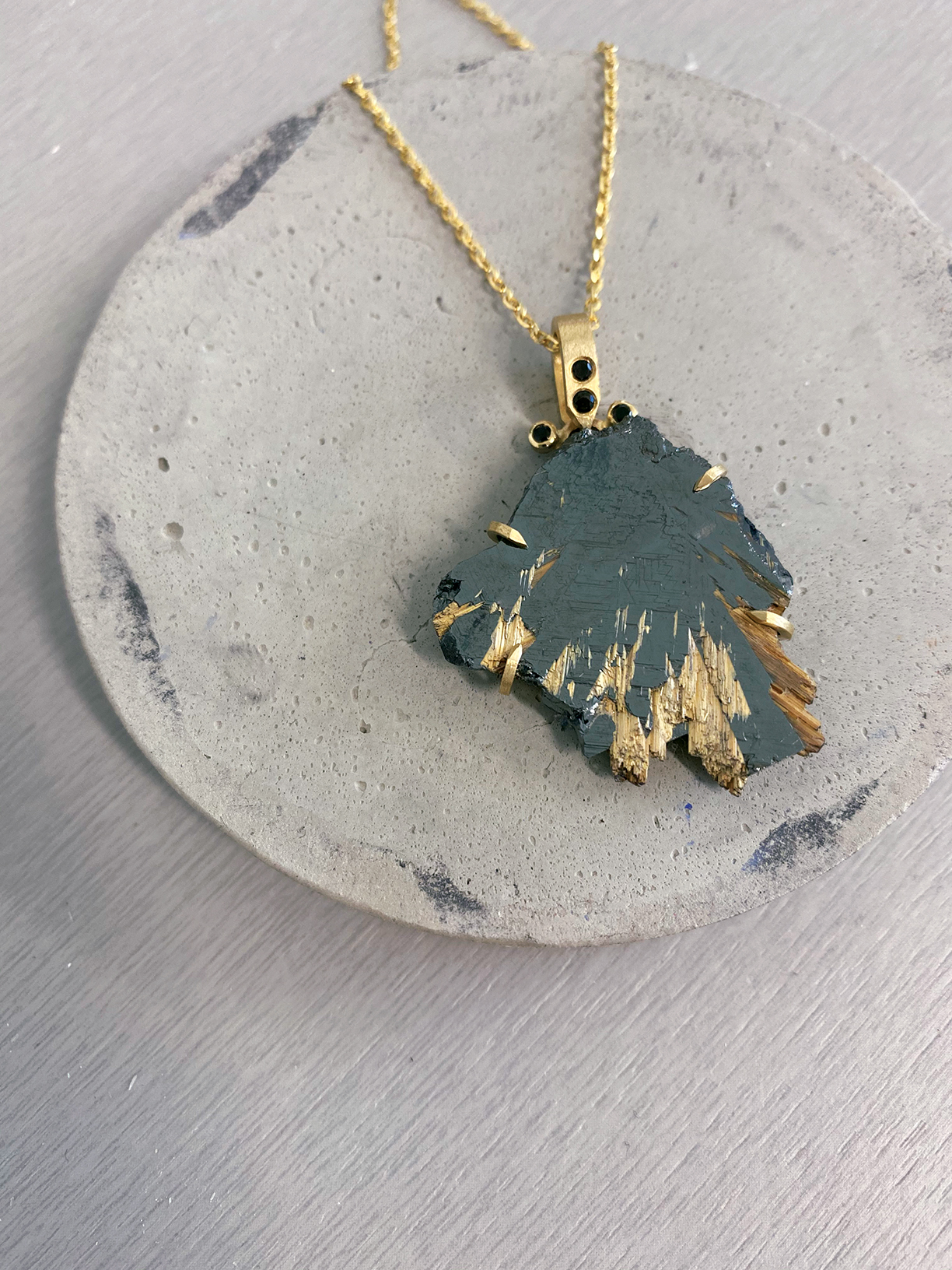
Photo courtesy of Enji Studio Jewelry
Grandics’s favorite recent creation, the Ankoma Pendant. It’s made of rutilated hematite stone and hand-fabricated with recycled gold.
Enji — its name derived from Grandics initials “N” and “G” — goes beyond making modern and minimalist styles, but looks to shed light on issues in the industry that people may not be aware of, supporting projects that help end the use of toxic chemicals such as mercury, which is harmful to people and the surrounding environment.
Grandics’ future plans include putting together a map of where all the gemstones come from, creating “radical transparency,” something she believes fashion companies should start doing, along with becoming completely sustainable. “We only have this planet as far as I know and, given the scale of climate change, I think it’s imperative,” Grandics says. “If it can’t be reused, recycled, or biodegraded, it shouldn’t be in production, period.”
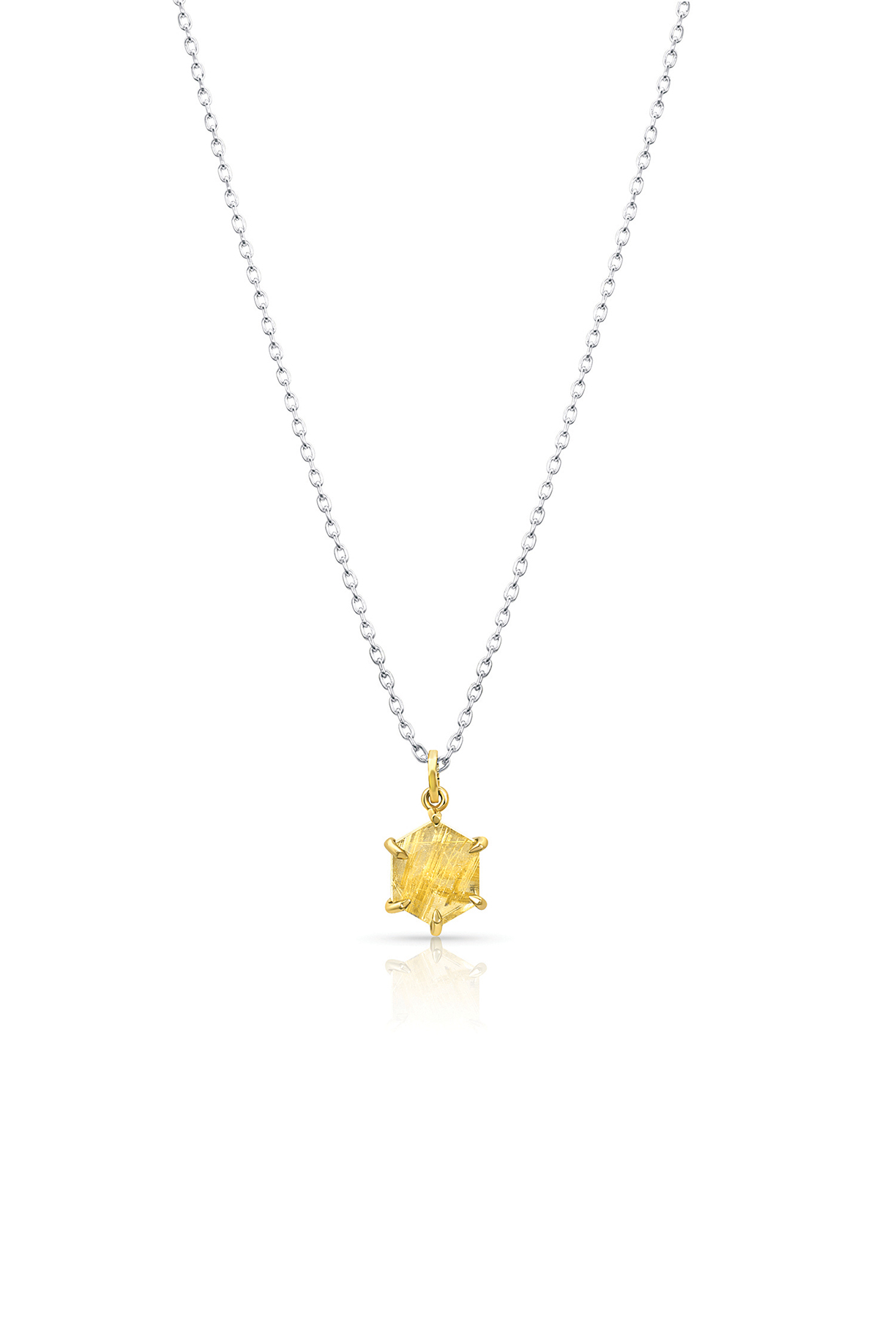
Photo courtesy of Enji Studio Jewelry
Aline Pendant: 2.25ct rutilated quartz and recycled 14k gold.

Paavo Studs: Recycled 14k gold, Montana sapphires and Canadamark diamonds.
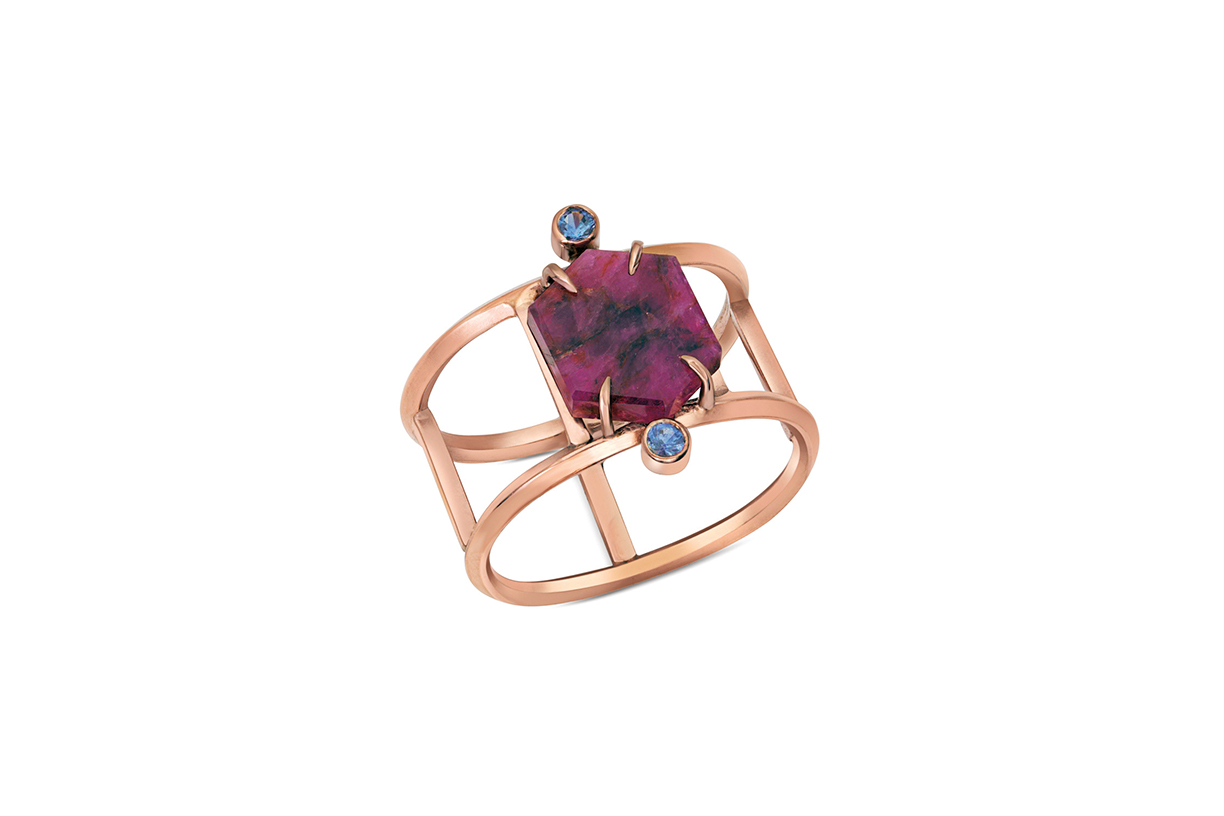
Photos courtesy of Enji Studio Jewelry
Faustina Ring: Ruby slice, Montana sapphires and recycled 14k rose gold.
Upon learning that her engagement ring possibly contained a conflict diamond, CEO and founder of MiaDonna Anna-Mieke Anderson knew she had to make things right for herself and the jewelry industry. “I started sponsoring Ponpon, a 7-year-old boy in Liberia, Africa,” Anderson says. “It’s through our letters that I got a first-hand look at the realities of living in a diamond mining community. I will never forget the day he wrote to me and said, ‘I had a great summer because only one of my classmates was killed.’”
Anderson set out to source conflict-free diamonds the best possible way she could find: growing them in a lab. MiaDonna has led the evolution in the lab-grown diamond industry, with the company debuting the largest USA-grown diamond at the time, at 6.28 carats in 2016. To help combat the issue, Anderson created a foundation, The Greener Diamond, that works together with MiaDonna, and empowers communities to grow food instead of mining diamonds. With each purchase of a piece from MiaDonna, the money goes toward programs that restore the lives and lands of people in sub-Saharan Africa affected by mining.
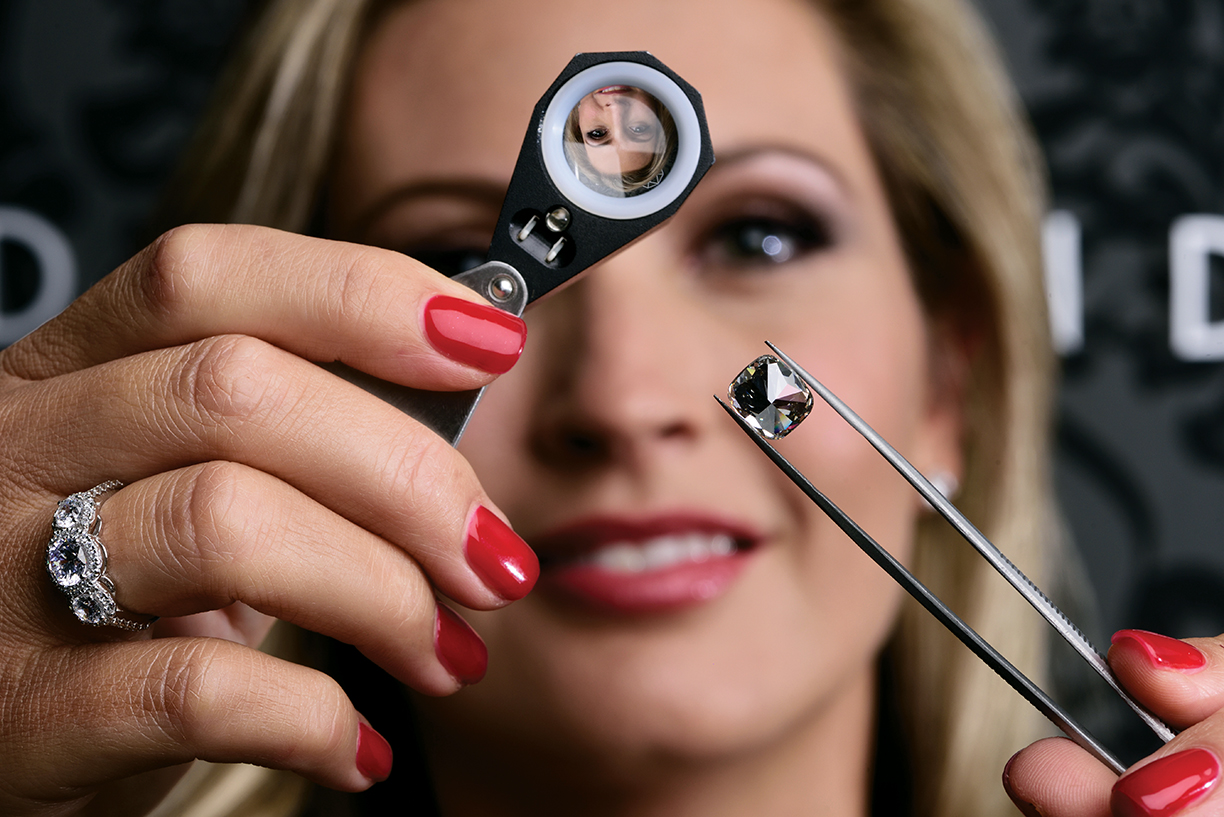
©2016 Alex Milan Tracy
Anderson’s company, MiaDonna, is named after the two most influential people in her life: her daughter, Mia, and her late mother, Donna.
According to Anderson, people should become more aware of where their jewelry is coming from because “every time we make a purchase, we are voting with our money.” Anderson is proud of where her company is headed, recently becoming B Corp certified in America, the first lab-grown diamond retailer to do so. But she isn’t going to stop there, looking toward the planet, her cause, and more importantly, the people, as her reason for making a difference. “As for the little boy, Ponpon, he just completed University and runs our foundation projects in Liberia, Africa.”

Custom lab-grown diamond ring by MiaDonna.

Photos courtesy of MiaDonna
Paris ring set with natural recycled diamonds by MiaDonna.
Whether you’re hosting a clambake on Nantucket, enjoying a procession of edible jewels at a Tokyo sushi bar or simply shopping for a suburban supper, the days of consuming seafood with careless abandon are gone. The oceans are desperately overfished, and seafood lovers must be conscious of their own personal impact on the aquatic environment.
The best known resource for both suppliers and consumers is Seafood Watch, a program created by the Monterey Bay Aquarium in Northern California 20 years ago. Its regional consumer guides, identifying the most sustainable and most threatened species, are valued by consumers, chefs and eco-conscious corporations. “We use a rigorous, scientifically-based standard to come up with recommendations, result-ing in the most up-to-date, credible information,” states Maddie Southard, content manager for Seafood Watch.
So influential are these guides—60 million have been distributed to date—that when a particular item moves from the red (“Avoid”) category to yellow (“Good Alternatives”) or green (“Best Choices”), millions of dollars can change hands. Reflecting the thoroughness of Seafood Watch’s recommendations, flounder appears four times as a “Best Choice,” 14 times as a “Good Alternative” and 18 times in the “Avoid” column depending on the exact species, geographic origin and methods of fishing or farming employed.

©Monteray Bay Aquarium, Photo by Tyson V. Rininger.
“Consumers help drive change, and when businesses recognize what’s import-ant to consumers they respond,” reports Southard of Seafood Watch’s ability to engage corporations like Whole Foods and Blue Apron. The program’s restaurant partners transcend economic strata, from trendy Farallon in San Francisco to family-friendly Red Lobster restaurants across the country.
In its early days, businesses viewed Seafood Watch as a fringe movement but today participation is embraced and display of the organization’s yellowfin tuna logo can be a marketing asset. A Blue Ribbon Task Force, comprised of honored culinary authorities, enhances Seafood Watch’s relevance with diners. “The public admires chefs and culinarians, and we realized the impact they have on consumers,” offers Southard, who adds, “Chefs were some of the earliest supporters of the movement so this was a natural partnership.”
“Whenever I’m making decisions about what to put on a menu, I always ask myself, ‘What would Sheila do,’” says Los Angeles chef Michael Cimarusti, referring to Seafood Watch’s Sheila Bowman, who oversees outreach to chefs. Cimarusti, who has earned two Michelin stars at his flag-ship restaurant Providence, became conscious of sustainable sourcing issues as a young chef in L.A. 20 years ago, when a Gourmet magazine review admonished him for serving bluefin tuna.
“As I learned more about issues relating to sustainability, I became really passion-ate about it and wanted to become more active in the movement,” explains Cimarusti. “I was honored to be asked to sit on the Task Force and have learned a tremendous amount from Seafood Watch,” says the chef, who shares all of the program’s recommendation alerts with his staff.
Éric Ripert, chef/partner of New York’s Le Bernardin, takes sustainability as seriously as Cimarusti. “I spend my days with many varieties of fish, considering which are best for the restaurant, he says. Ripert explains, “This means more than just judging by flavor and composition, but includes the ethics and politics surrounding how they’ve been made available to us.” The Michelin three-star chef cautions, “If we don’t support the artisanal way of catching fish, it’s going to disappear.”
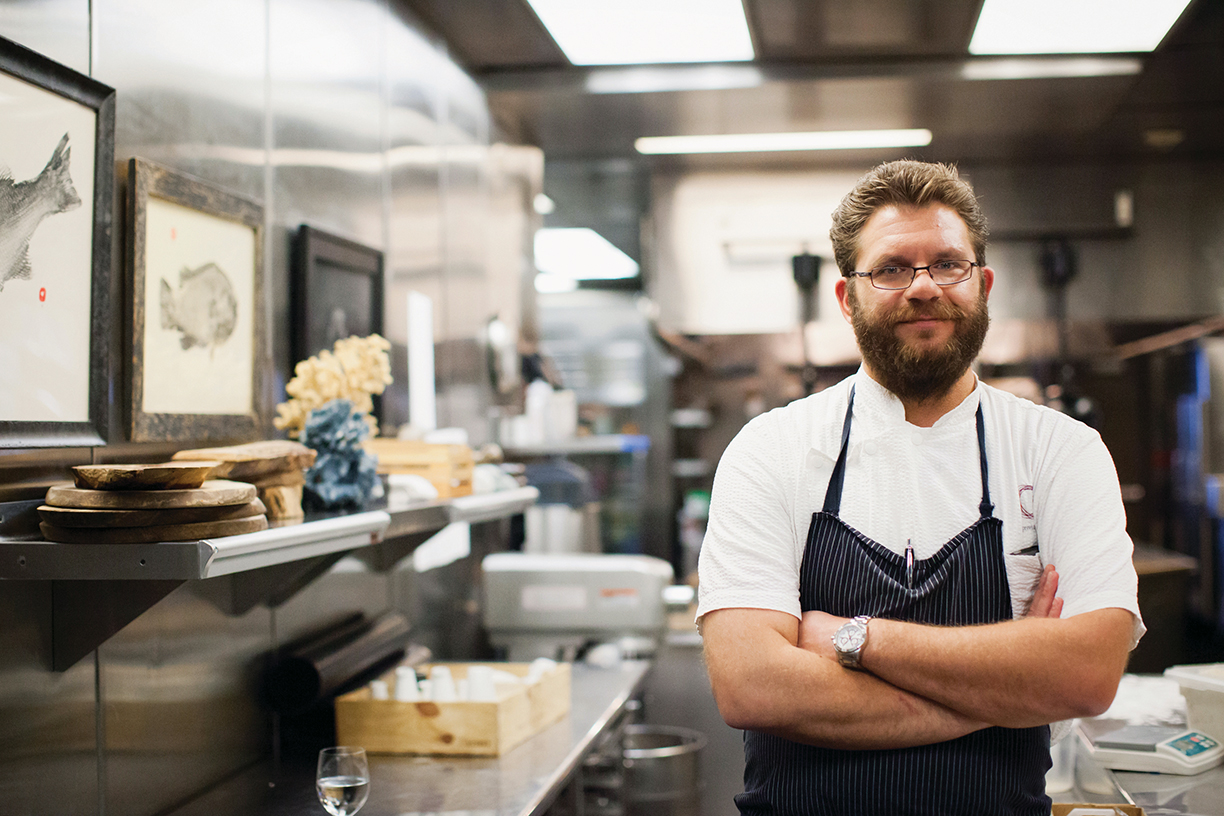
Michael Cimarusti. ©Jennkl Photography.
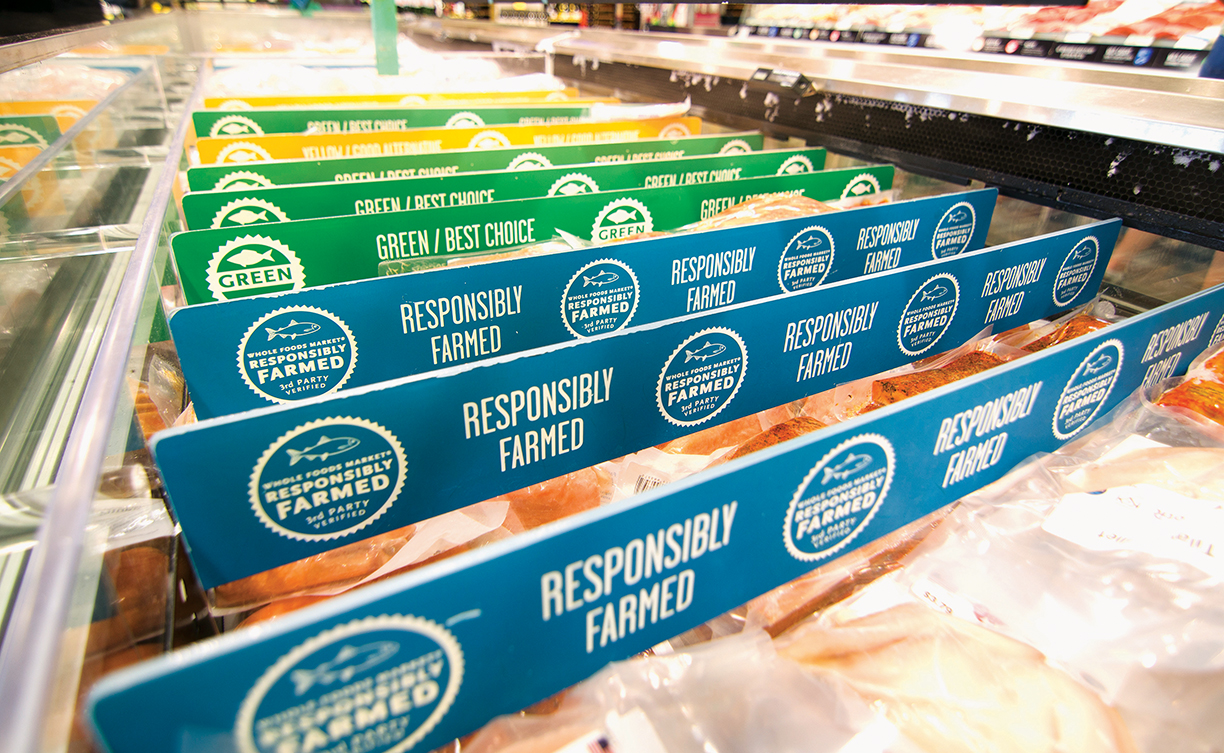
Courtesy of Whole Foods Market.
Hugh Acheson, author and James Beard Award-winning chef with a family of Georgia restaurants, also sits on Seafood Watch’s advisory board and is a strong advocate for local, sustainable ingredients. He recalls that in the 1990s chefs addressed a severe threat to swordfish through a voluntary ban and use of more sustainable alternatives, allowing stocks to replenish. “It made me realize how much clout we have, as chefs, to mandate change when we act as a plurality,” states Acheson.
“I think Seafood Watch has succeeded in being a valuable resource for consumers, chefs, wholesalers, and grocery stores,” says the Canadian-born chef who has helped reimagine Southern cuisine. Acheson, who notes that swordfish continues to face challenges, suggests Seafood Watch would have been an invaluable resource decades ago, when many chefs were oblivious to sustainability issues.
An affinity for bluefin tuna (maguro) and eel (unagi), both largely on Seafood Watch’s “Avoid” list, and adherence to centuries-old traditions makes sushi chefs among the most reluctant to adopt sustainable practices. One sushi chef committed to sustainability is Bun Lai, chef/owner of Miya’s Sushi in New Haven, Connecticut and another member of Seafood Watch’s Blue Ribbon Task Force. Some odd ingredients—every-thing from insects and invasive species to edible weeds—populate his voluminous menu, and the James Beard Award nominee relies on guidance from Seafood Watch.
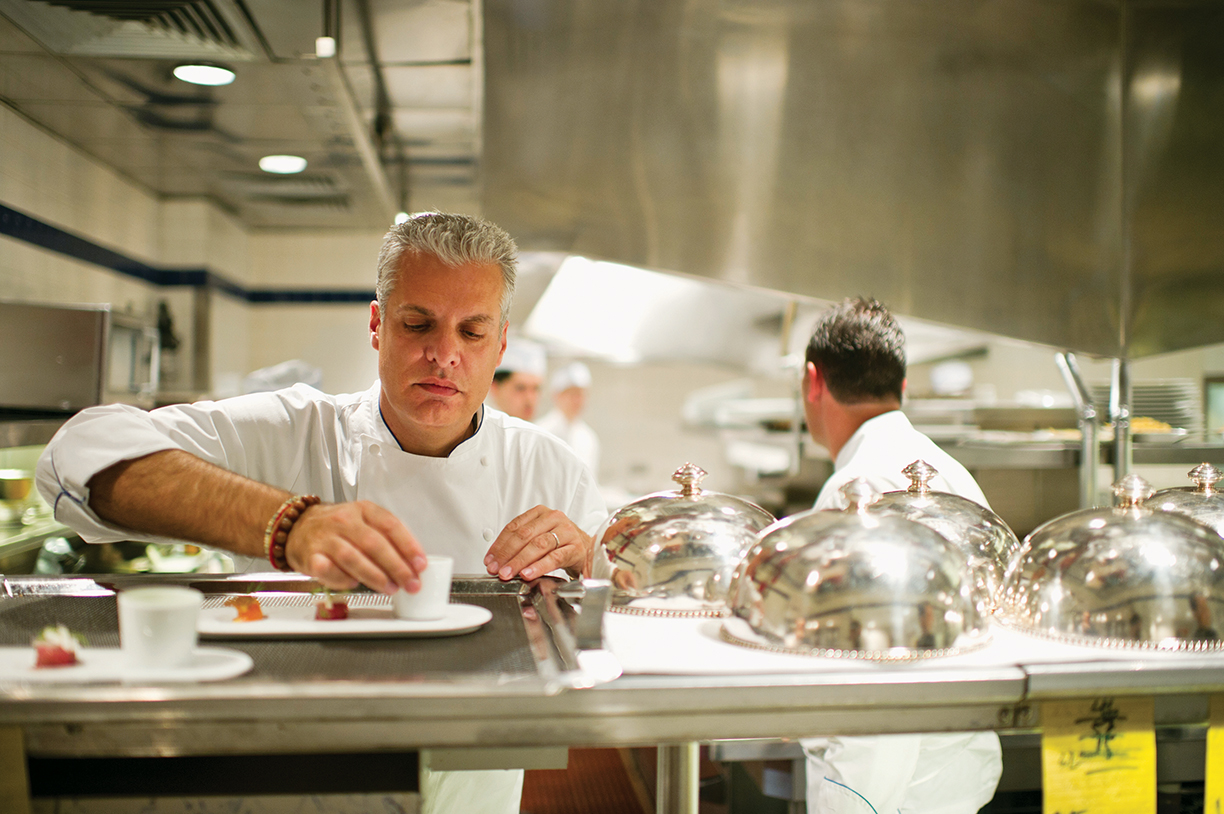
Éric Rippert. ©Daniel Kreiger Photography.
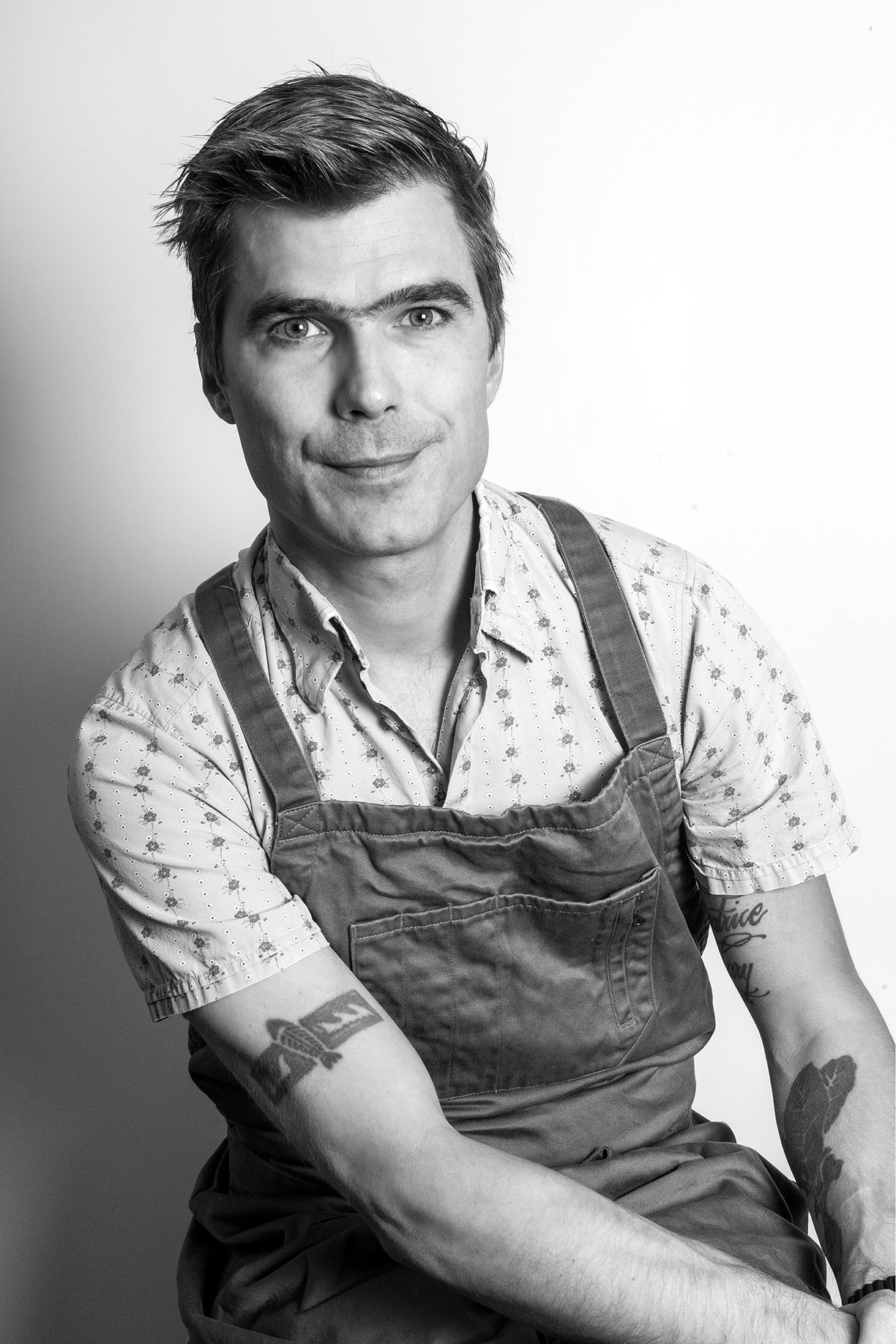
Hugh Acheson. Photo by Emily B. Hall.
“Miya’s started working on sustainable seafood very gradually in the early 2000s,” reports Lai, explaining that unreliable data made conscientious sourcing challenging. “Monterey Bay Aquarium’s Seafood Watch changed all of that by creating a tool that helped people choose sustainable seafood in a market awash with imported seafood of mostly dubious origin and quality,” says Lai. “When I first discovered Seafood Watch, it was as if a light beamed into the darkness I was surrounded by,” he says.
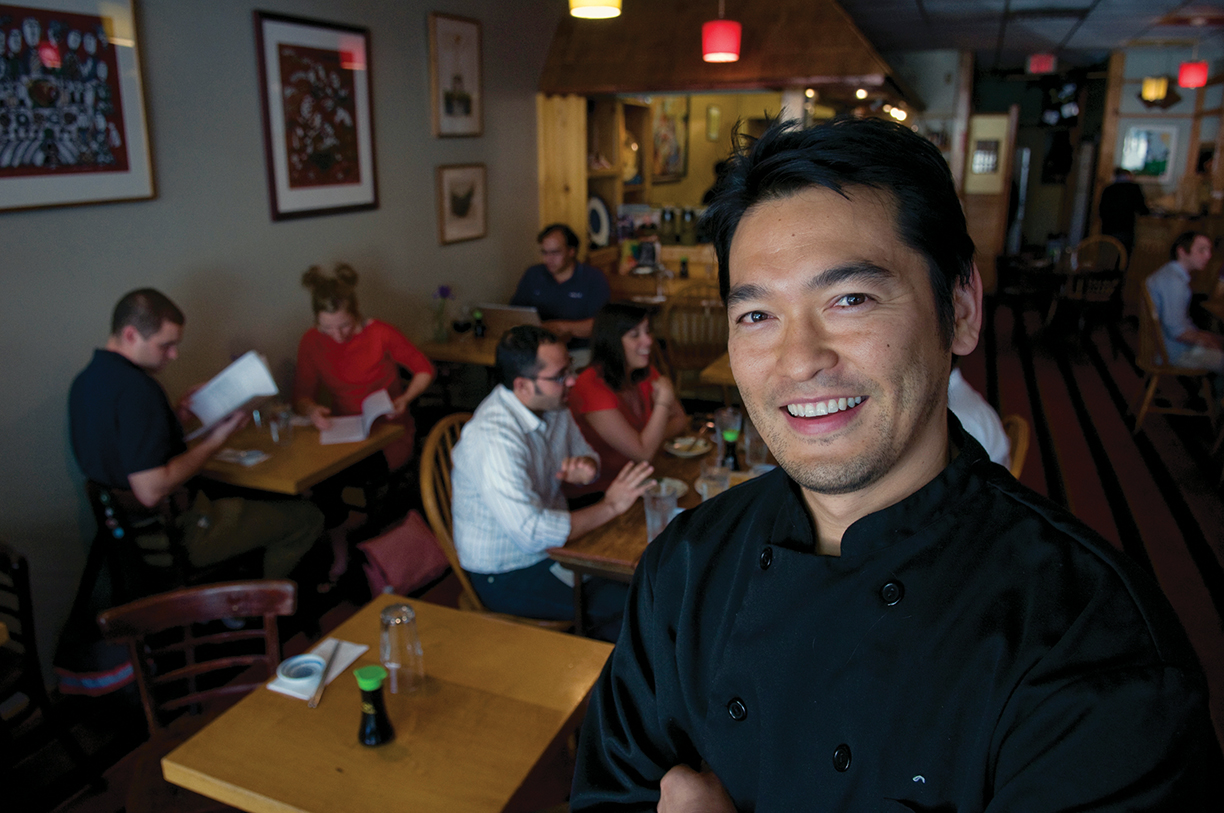
Bun Lai. ©Alan S. Orling.
“I admire my heritage, but we must question our traditions, too,” states Lai, acknowledging sushi’s popularity contributes to overfishing around the globe. He cites Jiro Ono, the revered sushi master featured in the documentary film Jiro Dreams of Sushi, who lamented the demise of the majestic bluefin while continuing to serve it to customers.
“There are, however, sushi chefs filled with a passion for sustainable seafood like those café owners who pioneered fair trade coffee decades ago,” says Lai with optimism. With Seafood Watch’s guides and app available to chefs and consumers alike, good choices can be made on both sides of the bar.
Sustainable Sources
Hugh Acheson
www.hughacheson.com
Le Bernardin
www.le-bernardin.com
Miya’s Sushi
www.miyassushi.com
Providence
www.providencela.com
Seafood Watch
www.seafoodwatch.org
Surrounded by the natural beauty of the pink himalayan salt blocks, salt spa visitors are encouraged to focus on their breathing as they embrace the benefits of the salt-infused air.
Dry salt therapy, or halotherapy, is a practice that originated centuries ago in the natural salt mines of Eastern Europe. Dry salt therapy is thought to provide an array of health benefits, helping with stress, anxiety, and depression, as well as skin conditions, arthritis and asthma.
“People are seeking more natural and alternative ways to feel better and relieve pain,” says Maryann Corcoran, co-owner of the Corcova Salt Spa in Genesee County, Michigan. “They are tired of taking pills and getting little or no relief and often additional ailments due to the side eff ects from their medication.”
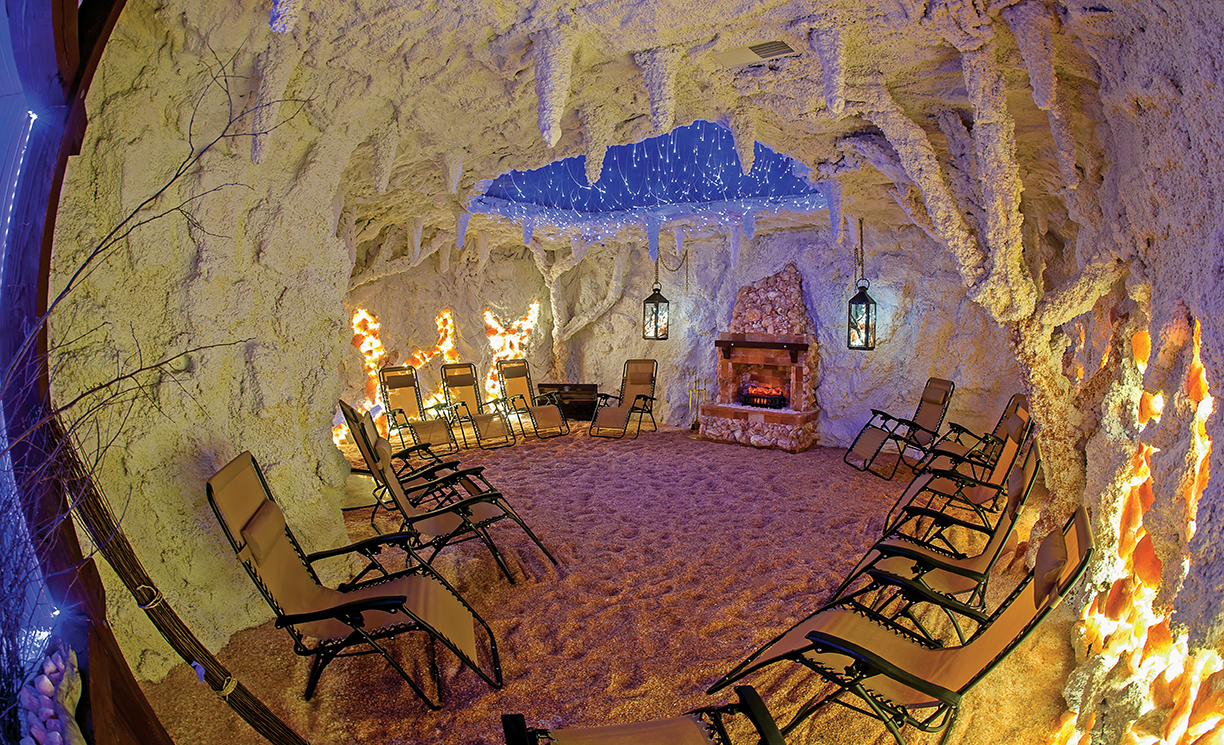
Royal Salt Cave & Spa. Photo by Rafal K Gdowski.
“With medications you have to worry about side effects and short- or long-term effects on the body, but with salt therapy, there’s none of that. It’s simply a healing process that also throws relaxation into the mix,” adds Izabela Przybyla, founder and owner of the Royal Salt Cave & Spa in Frankfort, Illinois.
A man-made salt cave reproduces the climate of a natural salt mine. Surfaces are covered with layers of himalayan salt and saline aerosol is
dispersed into the room to create a space that feels authentic.
“The salt cave is climate-con-trolled to recreate a micro-climate as if you were within a salt mine,” says Shannon Coppola, founder of Montauk Salt Cave in New York City. “Salt is super sensitive to heat and humidity. There is a very intricate climate-control system to ensure that the air is always moving and super clean to maximize the benefits.”
Chairs, whether recliners or loungers, are added for comfort and relaxation, while dim lighting is used to recreate a true cave-like experience.
One of the most well-known salt mines is the Wieliczka Salt Mine in Poland, which draws tourists from around the world. It was also the fi rst location to off er salt-related health treatments. In the 1830s, Dr. Feliks Boczkowsk began off ering salt baths when he began to notice the surprisingly good health of the local salt miners.
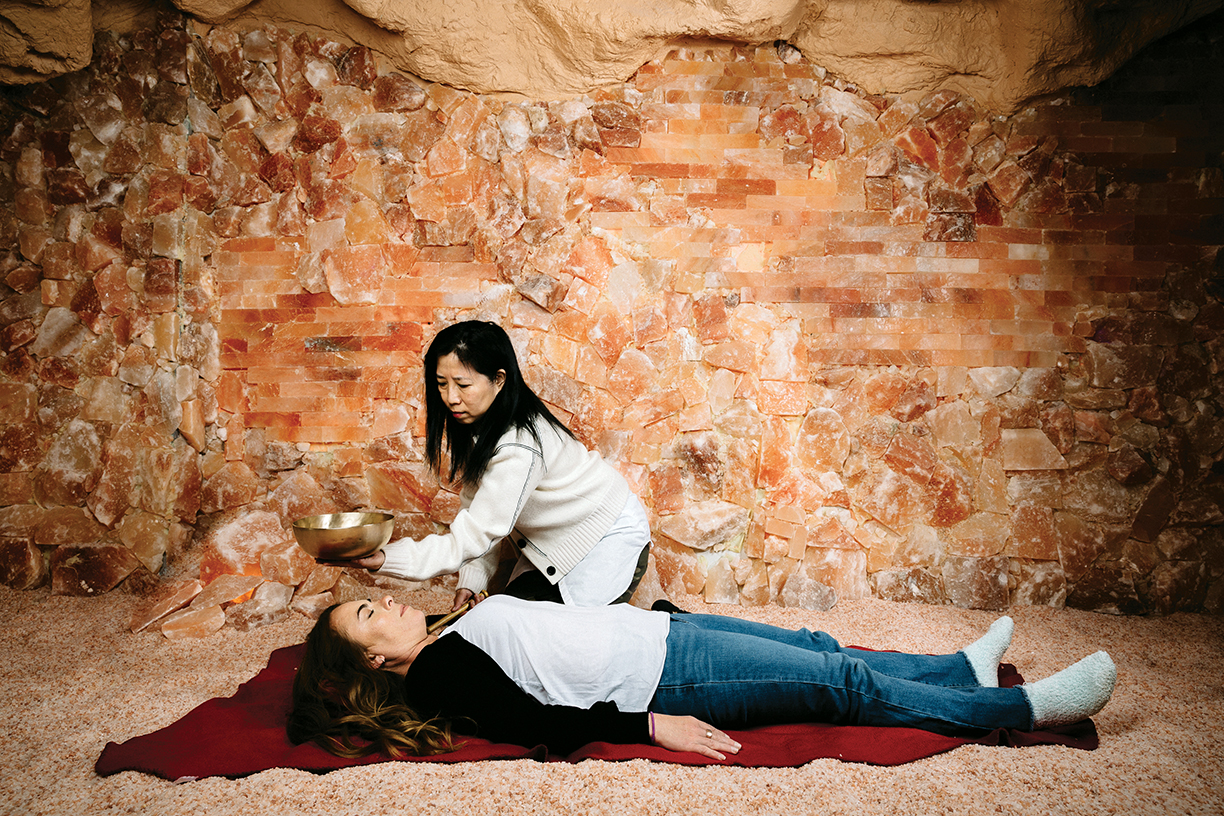
Mei Leung, a holistic healer at Montauk Salt Cave, uses Reiki and sound to help visitors feel calm and balanced. Photo by Mike Vitelli.
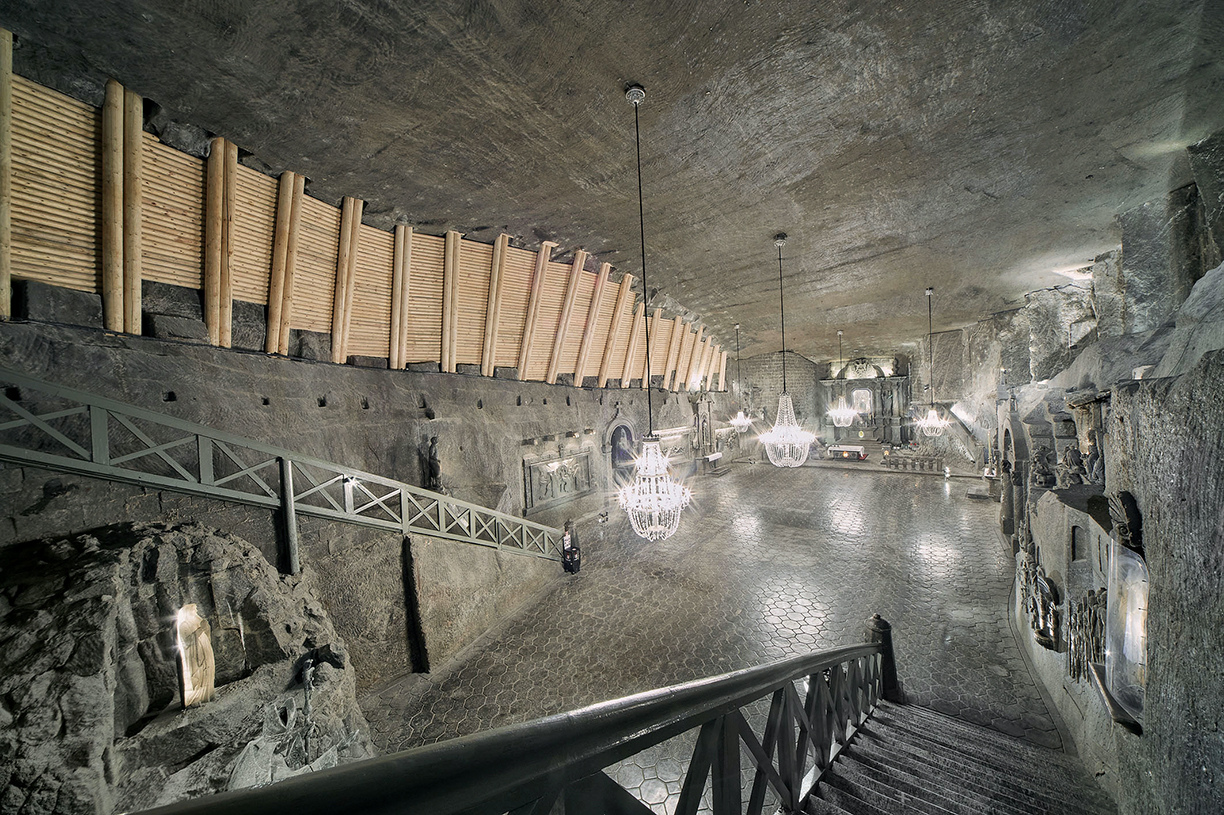
The historic Wieliczka Salt Mine began offering salt-related health treatments in Poland as early as 1830. Photo by Ryszard Tatomir.
United States spa owners draw inspiration from Wieliczka Salt Mine, which has played a pivotal role in the rise of halotherapy. Cheryl Krouse and Jim Fittante, owners of the Samana Salt Spa in Lewiston, New York, traveled to Poland to gain a deeper understanding of the ancient form of wellness therapy. “We were able to see firsthand how the Wellness Center in the salt mine has been operating since the late 1800s,” explains Krouse.
Another notable salt mine in Eastern Europe is the Salt Mine Berchtesgaden, which is the oldest active salt mine in Germany. The mine attracts visitors, who are able to tour the mine and learn of its history while taking in views of the natural salt. “Enjoy the underground, starting with a train ride. Go down two long slides (which were used by mine workers in former times), take a raft ride over a mystic salt lake, and see traces of colored salt in the rocks,” says Peter Botzleiner-Reber, tourism manager for Salt Mine Berchtesgaden.
“I’ve known about salt therapy my whole life, since I’m originally from Poland. Salt caves have been popular in Europe for more than 70 years,” says Przybyla, who has seen the trend grow in the U.S. in recent years. “There’s no doubt in my mind that salt therapy is on the rise simply because it’s relaxing and beneficial to your health.”
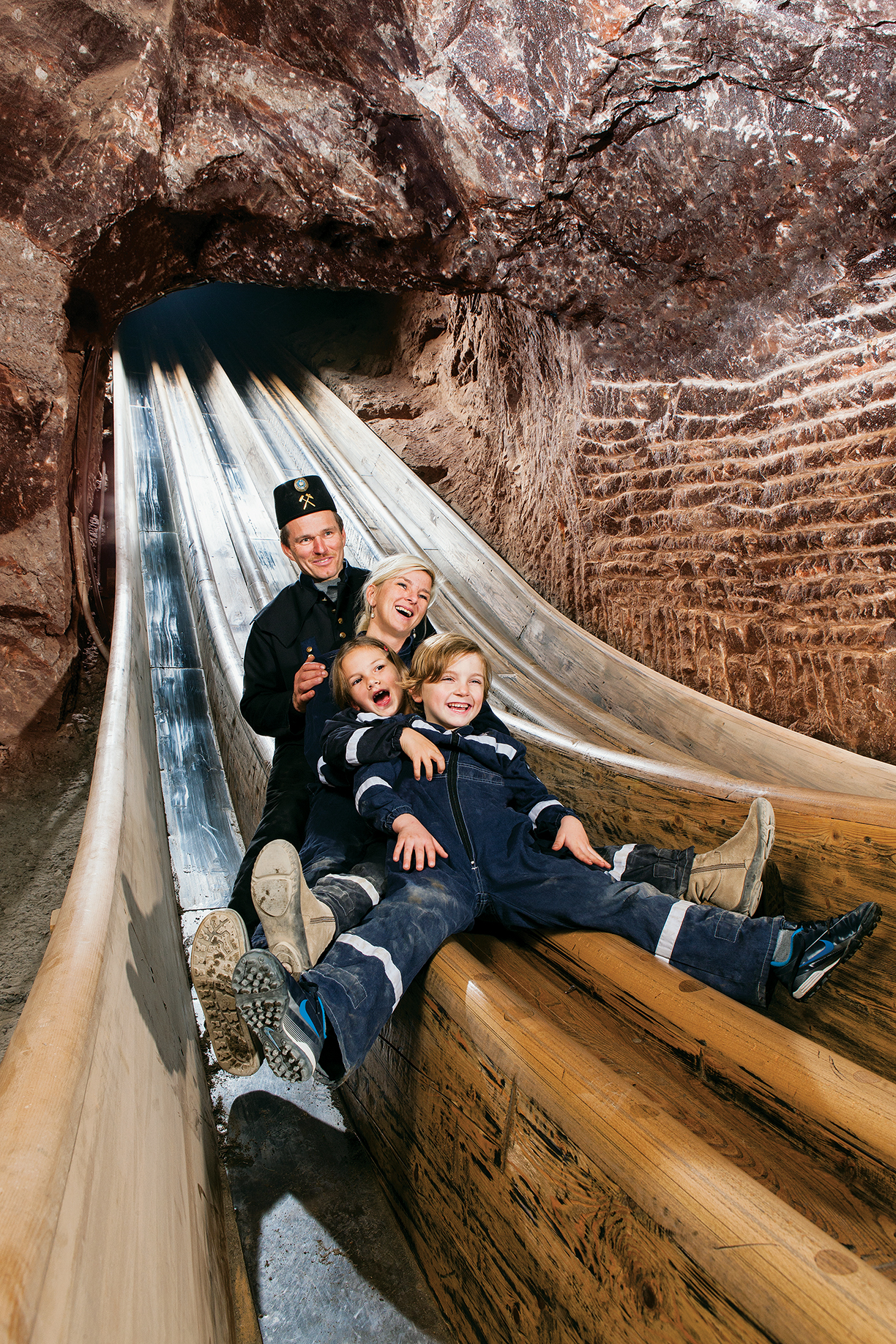
Salt Mine Berchtesgaden is home to two long slides, which are surrounded by salt and were once used by mine workers. Photo by Georg Grainer Fotografie, courtesy of Salt Mine Berchtesgaden, Südwestdeutche Salzwerke AG.
The salt used in halotherapy is antiviral, antibacterial, anti-inflammatory, antifungal, and antimicrobial, according to Shannon Coppola. To fully take advantage of its ben-efits, Coppola suggests a 30- to 60-minute session in a salt cave at least once a week — preferably two times a week.
While most salt therapy sessions are a solo experience, Montauk Salt Cave also offers guided sessions with experienced healers. The healers elevate the typical salt cave experience — whether it’s promoting peace and tranquility through the use of tarot cards and astrology, a meditative soundscape, or Reiki therapy.
Luxury developments and real estate properties are also experimenting with the benefits of halotherapy. “There has been an increase in awareness of the benefits of halotherapy and in turn a rise in demand for locations to off er it,” says Alison Howland, vice president of wellness programs and resourcing at Amrit Ocean Resort & Residences in Riviera Beach, Florida.
The luxury development will soon debut its inhalation halotherapy chamber, which will off er residents the opportunity to experience salt therapy from the comfort of their homes. “The concept of luxury is changing. No longer is standardized luxury acceptable. Personalized luxury is the new standard,” says Howland of the develop-ment’s decision to open the salt chamber.
For luxury spa owners, the choice to open a salt cave is often much more personal.
“My daughter was my biggest inspiration for opening this business,” says Przybyla. “She struggles with asthma and severe allergies, which tend to act up a lot seasonally. I wanted to help get her healthier in a natural way.”
Coppola echoes a similar message. “Ultimately, our inspiration for opening the spa was our son,” she says. Coppalo and her husband discovered salt therapy in 2014 when searching for a cure for their son’s respiratory issues. “We had tried everything under the sun — nebulizers, chambers, adenoidectomy, tonsillectomy, Flonase, Nasonex, and more. A friend suggested salt therapy. After one session, he slept through the night for the first time at 4 and a half years old,” says Coppola.
For years, Rolls-Royce Motor Cars has been at the pinnacle of style, class and design. What people may not be aware of is the company’s dedication and connection to art. The iconic luxury car company continued its expansion into the art world for a good cause in September, teaming up with famous British artist Marc Quinn.
The production line of Rolls-Royce in the founding location of Goodwood, West Sussex, England provided the stage for the company’s “Evelina Art for Allergy x Dine on the Line” philanthropy event where a generous £1.7 million was raised through an auction to support allergy research by Evelina London Children’s Hospital.
“Rolls-Royce was introduced to the charity Evelina London via connections in the art world,” says Jessica Persson Conway, manager of Art Programme & Philanthropy. As the largest allergy service of its kind in Europe, Evelina London provides specialized care to children across the country who suffer with an allergic condition.
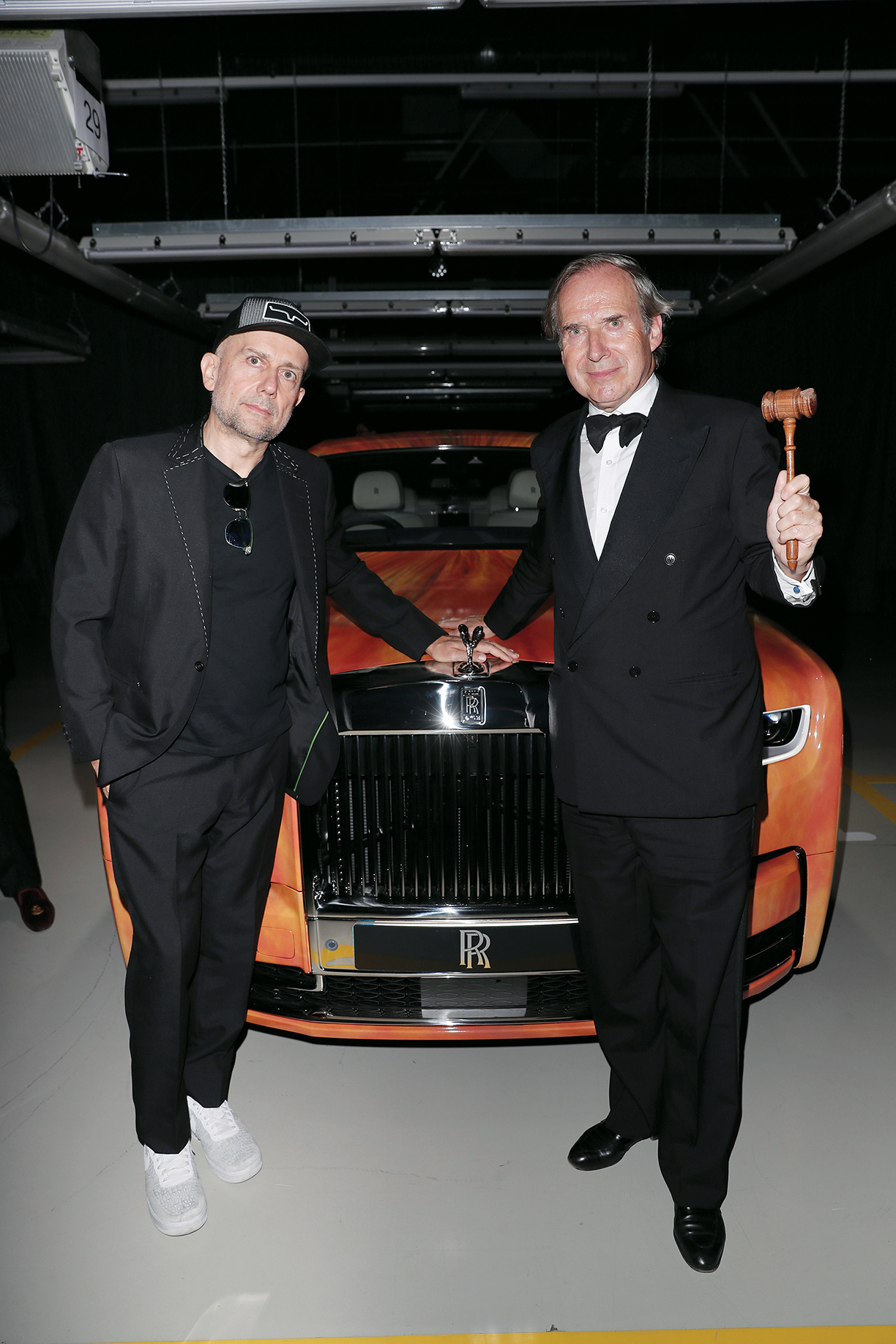
De Pury led the successful night featuring Quinn’s mesmerizing work. ©2019 David M. Benett.
“Marc is a world-renowned contemporary artist,” Conway continues. “Rolls-Royce has great respect for his work and particularly admire his Iris paintings, which is the subject chosen for this collaboration.”
Everyone locked eyes on the big prize of the night, a Phantom designed with one of Quinn’s pieces from his collection entitled “We Share our Chemistry with the Stars.” The ongoing collection features large, colorful paintings of irises from eyes.
Art auctioneer Simon de Pury, who led the vivacious auction compared the artwork to that of the psychedelic Phantom V owned by John Lennon, calling it “the 21st century equivalent.”
Phantom is the apex model of Rolls-Royce and the company, encompassing the luxurious experience of driving and owning a Rolls-Royce.
“The car has been the canvas of some of the most extraordinary expressions of bespoke craftsmanship,” Conway says. “The Rolls-Royce Bespoke Collective work hand-in-hand with patrons around the world to bring unique and highly personalized creative visions to fruition.”

The prized Phantom featuring Quinn’s artwork. Photo courtesy of Rolls-Royce Motor Cars.
The winning bidder of Quinn’s creation won the opportunity for the artist himself to create his own bespoke artwork featuring the iris of the bidder’s daughter, using the Phantom as the canvas. The drivable work of art raised an outstanding £888,000.
Rolls-Royce’s affiliation with art stems from its beginnings as a company, with the different models of cars becoming an “expression of creative will.” Conway noted that for over 100 years the bonnet, or front-hood, of each car is “graced with the Spirit of Ecstasy, a figurine created by sculptor Charles Sykes.”

The “Spirit of Ecstacy” by sculptor Charles Sykes. Photo courtesy of Rolls-Royce Motor Cars.
In 2014, the company founded the Rolls-Royce Arte Programme, an initiative made up of commissions with leading artists and institutions. Recently, the company announced a new vision for the program called Muse.
“Muse will further Rolls-Royce’s relationship with art through two new biennial initiatives, the Dream Commission and the Spirit of Ecstasy Challenge,” Conway says.
The company also prides itself with its devotion to philanthropy, emphasizing how events, such as “Dine on the Line,” bring important attention to charity organizations.
“Patrons of Rolls-Royce are often highly successful, noteworthy individuals, many of whom are major philanthropic donors,” Conway says. “It gives us great pleasure to introduce the Rolls-Royce network to such a worthy cause.”
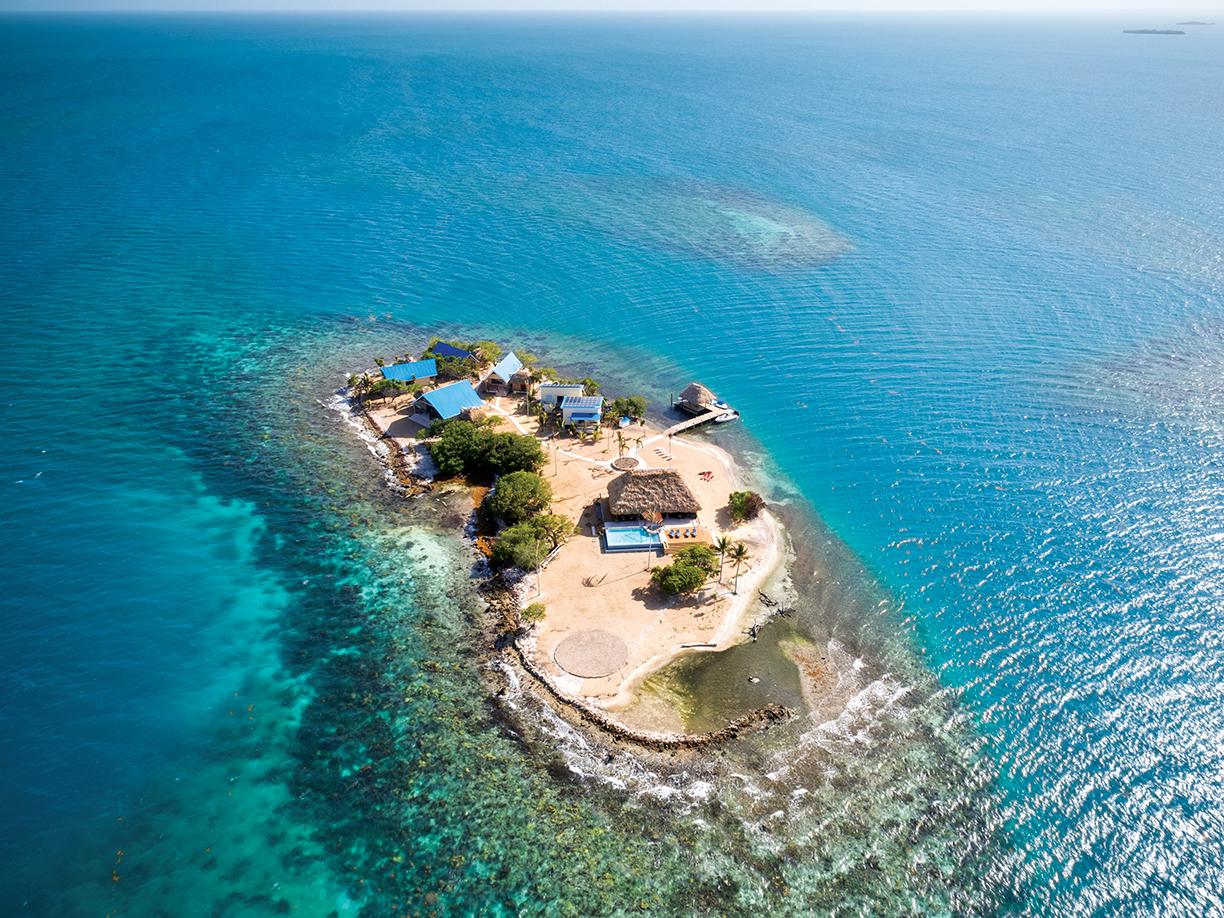
PHOTO COURTESY OF VRBO
More travelers than ever seem to be eschewing traditional hotels and considering lavish vacation rentals for more authentic and comfortable experiences.
Vacation rentals, from cottages to castles, can elevate the overall experience of traveling while avoiding that unsettled feeling of being away from home. Travelers can relish in the privacy of their own space and choose a rental that offers the peace and downtime traveling requires, all the while taking advantage of the same amenities and luxuries offered at a hotel or resort.
“The best luxury rentals can offer fine architecture, artwork, and furnishings that can rival the decor of any 5-star hotel, but without the transient feeling of being in a hotel. It’s as if you’re living in a place that is meant to be lived in, which can emphasize the sense of a place,” says Carol Perehudoff, an award-winning travel writer based in Toronto for the travel site Wandering Carol.
Whether you’re staying for the weekend or a few weeks, skip hotel rooms that can feel secluded and away from the excitement and embrace the idea of your own schedule and space.
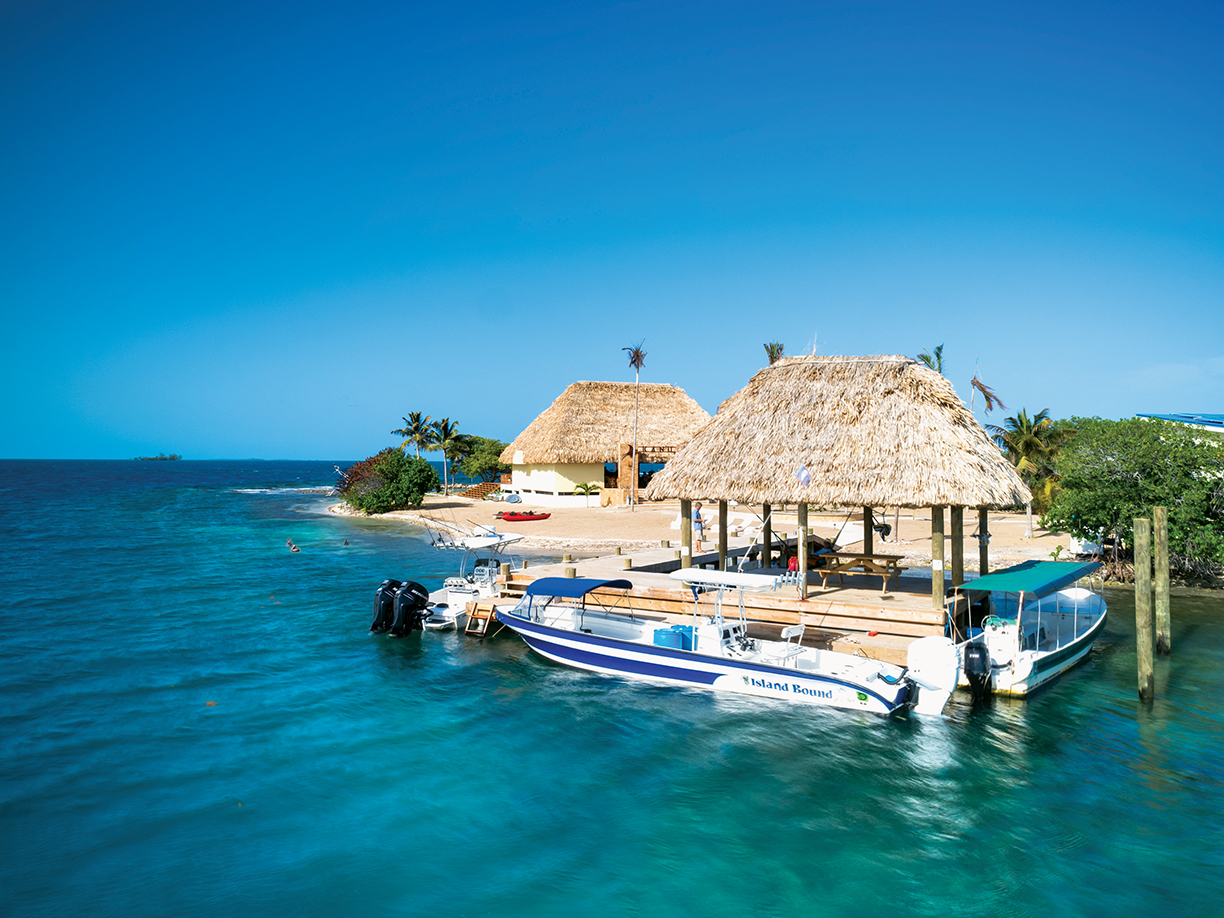
PHOTOS COURTESY OF VRBO
An Authentic Experience
Luxury travelers are looking for a more authentic adventure when they visit a new place. They want to experience profound architecture, personalized activities, and the overall culture in an area. “Travelers can have an all-inclusive resort-like experience with the added bonus of space and privacy to completely relax and spend quality time with their loved ones,” according to Alison Kwong, travel expert for Vrbo (Vacation Rental by Owner). Renting a vacation home immerses you in the surrounding culture to create your home away from home. “Oftentimes a vacation rental can be a better all-around experience. We use high-end vacation rentals as a base of operations for custom-built adventures,” says Dan Austin, the president of Austin Adventures.
Vacation rentals make authentic travel seamless. Visit hard-to-reach places or lesser-known destinations in a home rather than a hotel. Easily submerge yourself in a residential area rather than skim the surface of the commercialized options typically available for tourists. “You’re often staying in neighborhoods where residents live, rather than in tourist zones,” says Perehudoff. She describes one luxury vacation rental in Venice as being “as much of a cultural thrill as visiting a famous museum or palace.”
Space and Privacy
Space is a significant component to consider when vacationing with family and friends. There are endless rentals that sleep large groups comfortably, which means your party can stay together without feeling crowded or overwhelmed. “Vacation homes are ideal for traveling with family because they allow everyone to stay together under one roof,” says Kwong. Similarly, Austin says, “you can create a better “gather” type of environment … to create bonding moments.” He notes, “one of the biggest benefits is privacy.”
Lounge by the pool, fit in your morning workout, enjoy an afternoon snack, or take a midnight swim all in the privacy of your own space. Forget overcrowded hotel pools, spas, and restaurants when you have easy access to your own private pool, at-home theater, sauna, and other amenities.
Freedom with Amenities
Forget dining on a schedule or mid-morning interruptions. Renting a home offers the desired freedom on a vacation that runs on your own schedule, without sacrificing any of the luxuries. “Travelers can still enjoy special amenities, like private chefs, daily housekeeping and concierge services that organize itineraries full of activities personalized for guests and their families,” says Kwong. Everything from welcome baskets to day excursions and transportation are available.
The Right Choice
Vacation rentals can provide accommodations for groups without the financial strain of booking several hotel rooms. Family and friends can split the cost of a home with the added bonus of endless amenities at your fingertips. “Travelers are increasingly drawn to vacation homes instead of hotels or resorts when going on family or group trips because vacation homes provide the same value at a compelling rate. When renting an entire vacation home, travelers also have access to more space and privacy, better amenities, and the chance to stay in some truly unique properties that aren’t available just anywhere,” according to Kwong.

©ISTOCKPHOTO.COM / SHIRONOSOV
Vacation rentals are perfect for large parties who want to create gather experiences without feeling crowded.
Hotels can become a necessity rather than a welcome addition to your travels. Vacation rental companies have their own special niche, while the overall goal of each is to craft a unique, authentic experience for travelers.
Companies with a Purpose
Vrbo is based on the more traditional sense of a vacation rental. Families and friends are offered the privacy that large gatherings crave. Forget overloaded resorts and stuffy hotel lobbies. Instead, stretch out in front of your own fireplace with a book, make a cocktail in your private kitchen, and head out to the pool or spa where you and your guests can relax in privacy.
“Over the last 25 years, Vrbo has grown into a global community of homeowners and travelers with more than 2 million unique properties around the world, ranging from cabins to beach houses and every kind of space in between,” says Kwong. The site began in 1995 and has only expanded over the years, now offering easy-to-use technology to plan a dream vacation.
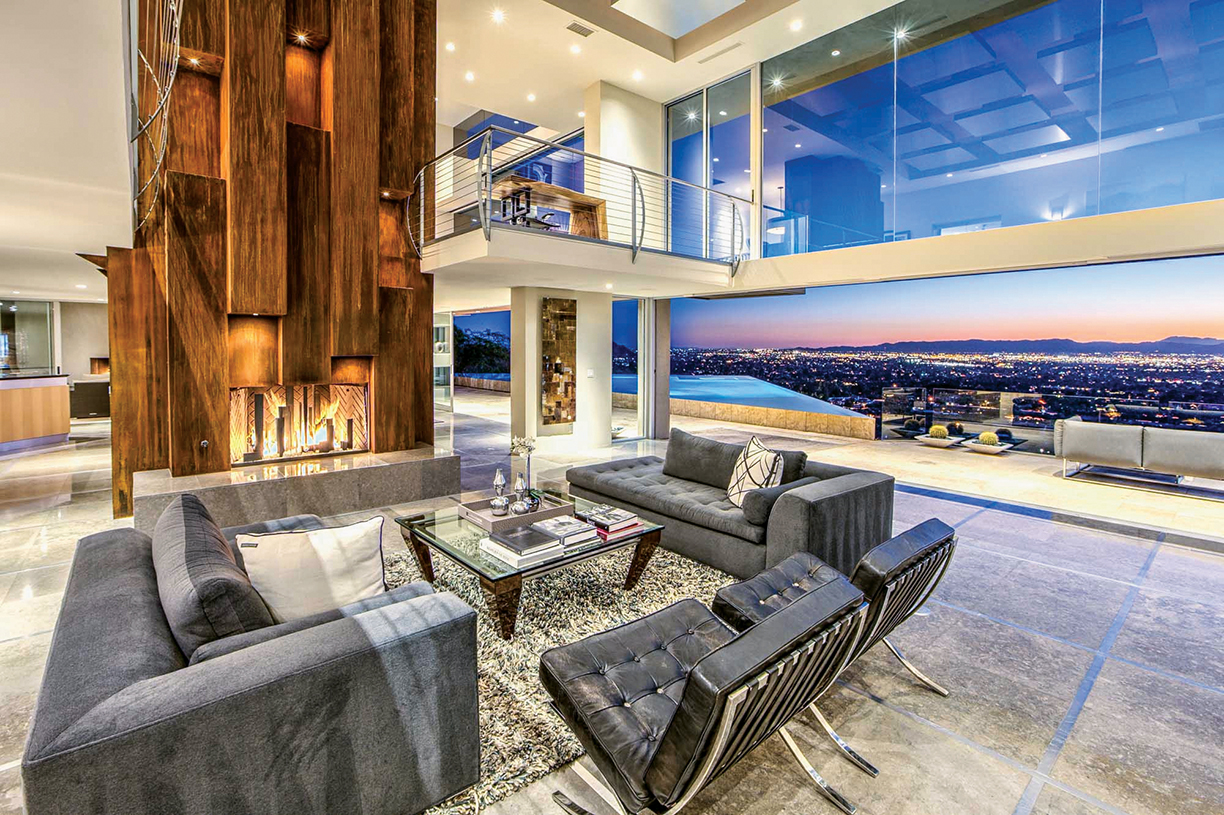
©ISTOCKPHOTO.COM / SHIRONOSOV
Rental sites offer the opportunity to stay in one-of-a-kind homes all over the world for a unique experience.
“One of the newest features Vrbo has added to the site are virtual tours, which pro-vide immersive, 360-degree views of vacation rental properties directly from the listing page,” according to Kwong. “Vrbo makes planning a trip together feel as effortless and enjoyable as being on one. Recently introduced, trip boards is a collaborative tool that allows multiple people to share, vote and collaborate about their favorite properties. That way, everyone is involved in the decision-making process and travelers feel confident that the vacation rental they choose is suitable for everyone.”
The trusted brand Airbnb is one of the more well-known services when renting a space, whether it’s for vacation or business. The luxury facet of the company, Airbnb Luxe, offers a trip designer for personalized activities that are specifically crafted for you and your guests. In tandem with activities and amenities, these ultra-luxury properties appeal to those with an interest in design and have been carefully chosen for that very reason.
PlansMatter is a platform that provides architecturally significant hotels and vacation homes for rent. For those with a special interest in spectacular architecture, travelers can choose from the likes of Pole House, a home in Australia that is suspended 40 meters above Fairhaven Beach; Vila Vals in Switzerland, which is built directly into the mountain scenery; the circular Solo House in Spain, and many more. “One of the highlights of a vacation rental is being able to get away from the crowds and enjoy more natural surroundings,” says Perehudoff. This is a component that can be overlooked when the simple convenience of a hotel is presented.
PlansMatter provides comprehensive information about architects and the properties that will boost the overall experience from the very start of a trip. Everything needed to decide, from photos and customer reviews to blueprints of the home, even a chance to read about the architects, is available.
Vacation rentals are growing in popularity today as a smarter way to travel for groups and for those searching for an authentic experience, but the concept has long attracted savvy and avid travelers. Founded in 1986, Windows on Italy carefully selects prestigious villas and apartments throughout Italy. From Florence to Rome, the countryside to the seaside, rentals with private pools, frescoed lofts, antiques and more will enchant travelers. The brand is another that focuses on one-of-a-kind, top-tier properties that heighten the overall travel experience.
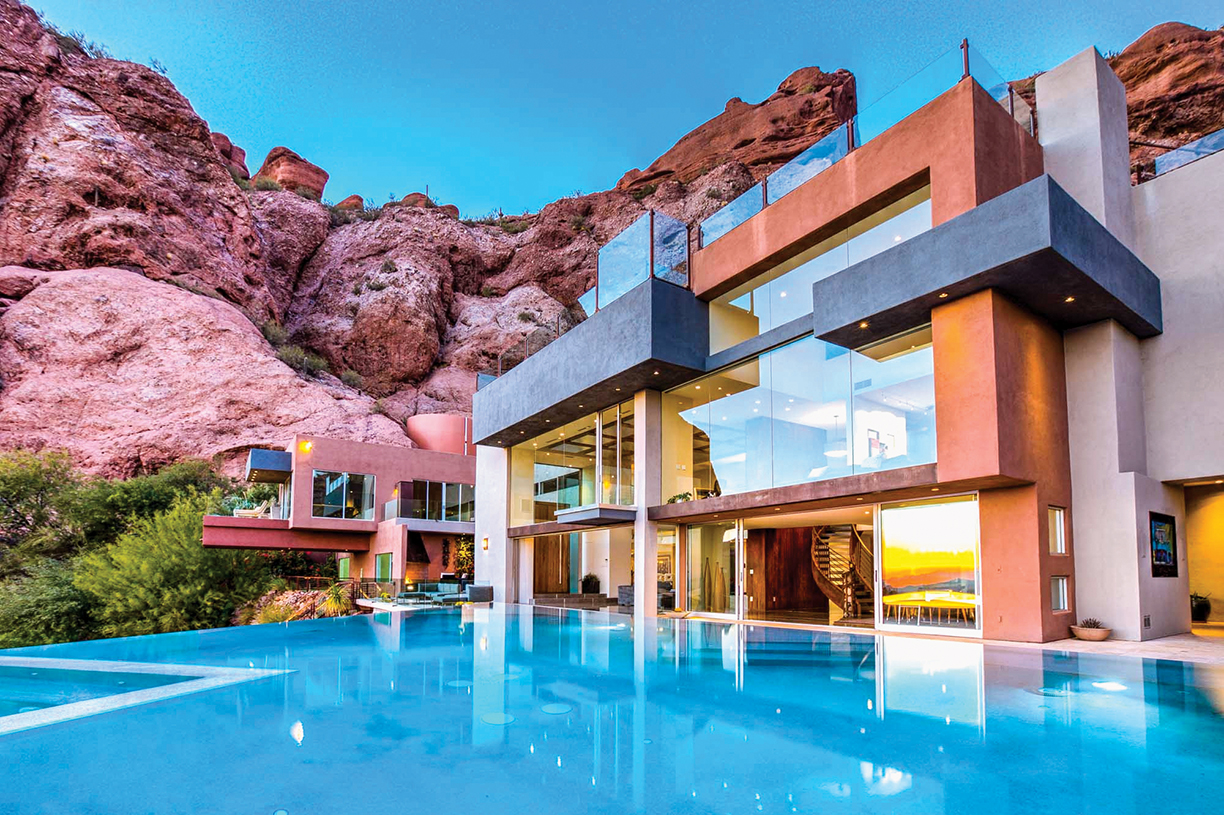
©ISTOCKPHOTO.COM / SHIRONOSOV
Experience profound architecture when staying in homes such as this gorgeous Scottsdale, Arizona property.
This editorial originally appeared in The High End Winter 2020.
